Quick links
To other sections and pages within my website...
Community:
Join the discussion forum to ask questions, make comments, vote in polls, rate your favourite tequilas, discuss Henry Hudson, Triumph motorcycles, harmonicas, read tequila industry news, and meet other tequila and bike aficionados. You'll also find my blog there.
Jump to a brand or section:
Separate page:
Weights
Mene mene tekel upharsin. Here's what I get using a postal scale to weigh these harps (without their carrying cases):
Suzuki Pipe Humming: 170g (P)
Hohner XB-40:
106g (P)
Harmonix modular (no microphone): 94g (P)
Suzuki Promaster & Promaster Valved:
93g (A)
Hering Vintage 1923:
84g (W)
Seydel Soloist Pro 12: 82 g (W)
Suzuki Overdrive:
82g (P)
Huang Star Performer:
74g (P)
Hohner Big River:
73g (P)
Suzuki Firebreath:
71g (W)
Suzuki Bluesmaster:
68g (P)
Turbo 20: 68g (P)
Turbo BX: 66g (P)
Seydel Blues Session
Augmented/Dorian/LLF:
66g (P)
Bushman Delta Frost
Low F: 65g* (P)
Lee Oskar diatonic:
65g** (P)
Seydel Blues Session:
64g (P)
Bushman Delta Frost &
Soul's Voice: 64g (P)
Hohner Golden Melody:
64g (P)
Hohner Special 20:
63g (P)
Huang Bac Pac:
62g (W)
Huang Silvertone Deluxe:
62 g (P)
Hohner Marine Band:
60g (W)
Merano:
57g (P)
Johnson Blues King:
56g (P)
Hohner Blues Harp:
55g*** (W)
Harmonix replacement reed cartridge: 54g (P)
Seydel Big Six: 53g (W)
Hohner Puck:
31g (P)
Notes:
* Low F weighs 1g more than the standard keys.
** Both major and minor keys weigh the same.
*** This particular harp is 20+ years old, so newer model harps
may be different weight. I have read Hohner is using thicker
metal for its covers these days.
A = Aluminum comb
P = Plastic/ABS comb
W = Wood comb
S = Stainless steel (so far the only one I've read about with SS
reeds is the Seydel 1847)
170g is approx. 6 oz, 65g is approx. 2.3 oz., 55g is approx 1.9 oz.
Copyright
This site and any pictures taken by the author are copyright © 2007, 2008 Ian Chadwick. Images in the forum galleries are copyright © their respective owners. Please do not copy or use either without prior permission.
Donations
To help me defray costs of maintaining this site and my forum, I
would very much appreciate your donation. Use the Paypal button
above (or make any online payment service payment through Paypal
directly to me at
ichadwick@rogers.com) Cheques and
money orders are also accepted (just be very careful when
sending the latter... always use registered mail or courier).
Send mail to:
Ian Chadwick, 115 First St. Suite 502, Collingwood, ON Canada
L9Y 4W3.
About me
I am a Canadian writer and editor, with a passion for history, sociology and the sciences. Click this link to read my biography.
Updated August 23, 2008
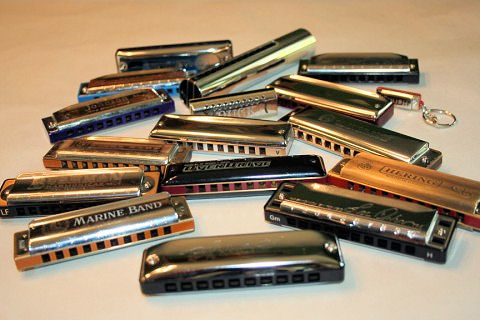
Wish list:
For future purchases: Seydel 1847 and Favourite harps, Hohner 365/28, Suzuki Folkmaster and Hammond, TurboHarp AX-S20, a Hohner 365 Marine Band, Steve Baker Special (G)a Hering 6020 Black Blues Harp (D) and a Hering 9020 Master Blues Harp (A), plus some alternate tunings and layouts (spiral, country, Irish, diminished, tremolo, octave and something in Low C). Plus a Harmonica Honker microphone.
Back to school:
I've been buying some harmonica-learning and repair DVDs and books, as well as looking on YouTube and other places online for lessons, tips and tricks. I'll add a page about what I've found, what works and what doesn't in the next month.
Counterpoint by Stephen Schneider
(Stephen kindly gave me permission to quote from his lengthy and very informative emails on the issues and questions I raised about harp technology and sound. I must take credit for any mistakes in the editing or organization of this material, but the research and insight belongs to him.)
Holes in the ends of the cover plates are important: the way the cover plates interact with your hands is the biggest single influence on the tone that listeners hear from the harp. How well one can completely wrap up and compress (darken) the tone, versus how much it brightens up when we open our hands.
The holes in the ends make for a brighter sound a lot of the
time, depending on whether one's hands are big enough to cover
the end holes up or not, and they extend the bright end of the
palette when the hands are fully open. The more open the covers,
the more highs get out & brighten the audible tone. Hohner
Marine Bands may have the widest tonal palette of anything
because they're small enough for many people to wrap up well,
yet very bright when the hands are fully open. The old-school
amplified blues players really exploited that.
Another mechanical point is that the size of the reed has an
effect on how loud the note can be, other things being equal,
and reed plates are generally built on two overall size
platforms for a given key: one could be called the Hohner
handmade platform (from Marine Band/Special 20/Golden Melody)
and the other could be called the Lee Oskar platform. The bigger
Oskar platform is noticeably bigger front to back, though the
width is the same.
Seydels and Bushman are variants in how they space the reeds
side to side, but overall an A harp, for example, will have
reeds that are about the size of a Marine Band's or a Lee
Oskar's, overall, and the bigger reeds can be louder. This is
most obvious if you compare maybe a Big River to a Marine Band,
in the same key, or Pro Harp to Special 20.
The thickness of the reed plates is also a factor in volume;
cheaper harps often have thinner reed plates to save metal and
are not as loud, with a tone that may be perceived as thinner
(plate thickness actually affects the harmonic overtones
generated). A Pro Harp will tend to be louder than a Lee Oskar,
a Hering 1923 will be louder than a Marine Band; similar cover
plates and combs and reed sizes for each pair, but different
reed plate thickness. Even a tenth of a millimeter is audible
(Chinese-built diatonic plates are generally at least a tenth
less thick than German plates; I think the Huang "25% more"
claim is about plate area for the Star Performer, not
thickness).
Tone and volume as perceived by the player vs. as perceived by
the audience/listener have been a hot topic in the past; the
former can influence a player's subjective evaluation of the
harp, yet not be perceived at all by the audience. It takes a
while to get past that one, and meantime, just make yourself
happy if you've got to play the thing.
Perhaps the most important single issue in evaluating stock
harmonicas is that seventy-five years ago, a Marine Band would
have been gapped and tuned by an actual human being who was
probably fairly skilled in gapping it in a style that would play
well. Today the harp may still be tuned by hand, but the gapping
of the reeds is done by a machine that slams a shaped shim under
all of them; when the shim pulls out, the reeds spring back to
wherever they feel like springing back to, and the resulting
playing action of the reeds thus will be more or less random,
depending on the buyer's luck.
The Suzuki PureHarp and Firebreath are the only two models of
diatonic I know of with proper, purposeful gapping (albeit for a
rather tight action); they seem to have developed reliable
mechanical gapping, at a premium in price (they may be
hand-gapped, but I doubt it - they're actually too precisely
done).
Hering does a really good job of tuning its just-intonated
diatonics (1923 and Hering Blues) by hand, if that suits one's
playing style; a lot of equal-tuned diatonic models (Oskar,
Golden Melody, Suzukis) are well tuned, ditto for playing style.
But really, apart from the above-mentioned Suzukis, at this
point, when you buy a stock harmonica, you are basically buying
raw material because the playing action will be the result of
chance.
The only way the playing action of a Meisterklasse is
intrinsically better than a Big River's is that the
Meisterklasse has thicker reed plates, making it a bit louder
for the same effort. Right there at the individual reed slots,
where the sound is made, there's no other difference. The two
types of cover plates are likely to interact with one's hands
differently (closed vs. open ends), but the price difference
between the two models is not buying performance, apart from the
volume issue.
Maybe Suzuki has extended their gapping method to the Promaster
models. But if you want to know what a properly gapped harmonica
feels like, a Suzuki Firebreath is the one way I know of.
I've been struck by the 'raw material' aspect of the whole
business in the last few days, working up a pair of the same
reed plates that I think come in the Johnson harmonicas
(formerly sold as Sousa Band and Mars Music and others in the
US). I reduced the excessive slot clearance of the reeds and
gapped them to rectify the action, then tuned it, and you
wouldn't recognize it for the same harmonica. It's intrinsically
flawed as a reed plate because they use odd-sized, very small 9
and 10 hole reeds, probably to save money, and those don't play
very well, but the rest compares well to a comparably set-up
Oskar. That's not something you'd expect from playing the leaky,
windy, awful stock Johnson, but it's a good example of how
important the reed setup is. The old blues heroes were playing
diatonics that were better than ours, at least till the 1960s
when harmonica demand went way up and Hohner automated more.
Some of the issues I talk about - cover plate openings, reed
plate thickness, reed size, comb material - are discussed at
length in the
Harp-L archives. There was enormous discussion and some
interesting blind public testing of that ca. 2000.
Two resources I think of for scientific research are
Dr. James
Antaki (aka TurboDog)'s papers, and
Pat Missin's
coverage of a lot of things. There was some seminal research on
reed behavior during bending that was done in Australia in the
early 1990s for journal publication, TurboDog has published a
number of things, and the accordion community has instigated a
certain amount of published research into "free reed" behaviour.
Pat Missin and Douglas Tate did a certain amount of personal
research which they talked about on Harp-L and Pat has his on
his site. Pat in particular has been looking into a lot of
things for a long time and is very reluctant to make unqualified
pronouncements, so his consideration of anything is very
informed and judicious. You'll find his harmonica model reviews
interesting because he looks inside them with a vastly
experienced eye for the setup & potential of a reed plate.
It's premature to generalize about the tuning and gapping of a
given harmonica unless you see dozens of examples of them, due
to the vagaries of production, but I do it anyway: after you've
learned to work on them and have seen the insides of hundreds of
them, you do notice certain patterns.
Some of the things I talked about you can test for yourself,
like the cover plate openings issue: high frequencies are
shorter wavelengths, physically, than low ones, so completely
wrapping up a harmonica in your hand cupping will trap the
highest freqs and you only hear the lower freqs (a 'compressed'
tone because the highs have been knocked off the EQ profile).
Open your hands and the highs assert themselves very strongly;
more open cover plates let still more of the shortest waves out
to the listener.
If you look into Chicago-style amplified playing, the way the
microphone is cupped in the hands is crucial to that sound: the
mic face needs to be at least a finger's width away from the
back of the harmonica or the highs overwhelm the lows--depth in
tone in that discipline is achieved more by subtracting highs.
That whole business of manipulating the EQ profile you're
projecting is part of playing the harmonica as a real
instrument, making full use of its potential, and I think for a
lot of people, understanding the underlying principles helps
their playing progress: since one can't gain much by visually
watching an instructor or expert play, compared to many
instruments, the conceptual/verbal side of things becomes more
important, and the fervent discussion of harmonica matters in
online forums is not as obsessive as it may seem to the
outsider--a lot of important things were literally not
articulated, not said in so many words in print anywhere, until
the 1990s, really.
Speaking of resources,
Ben
Felten in France,
G. in
New Zealand, and
Mike Will in the U.S. have maintained excellent
second-generation diatonic/chromatic information sites, writing
as what I would have to call enthusiasts though G has really
graduated to the professional level of knowledge by becoming the
go-to repair tech in New Zealand, as well as by continued
research.
Richard Hunter maintains another wide-ranging site.
It's a really important matter that the average consumer cannot
simply go to a retailer and be sure of buying a diatonic
harmonica that plays well - it hurts the instrument's appeal
because the beginner doesn't know whether problems are the
player's fault or the harmonica's, and a higher price for a
given model has been no guarantee of a harmonica with a better
playing action.
Right now, the PureHarp/Firebreath and the TurboHarp are the
only harps I can direct someone to as reliable. The major
harmonica companies are really missing out by not having Custom
Shop operations along the lines of Fender and Gibson guitars,
whose main production is not so much custom instruments as
standard models assembled by skilled luthiers, with some economy
of scale bringing the price down somewhat.
Anyone who's ever customized harmonicas for money will tell you
that it's a pain to have to spend time disassembling a harmonica
to start work on it; the factories could start with raw parts
easily. Simply to offer a skillfully hand-gapped and tuned
version of their standard models, with a repair schedule for
screwed-together models, would transform the market profile of
whatever company attempted it. Unfortunately I believe it's
tough to offer a living wage for that kind of work (ask a pro
customizer) at the margins the big companies want. All these big
companies suffer from the issues attendant on an enthusiast
product being supervised by people trained in business schools;
Hohner has improved immensely since around 1995 by listening to
its player reps, Seydel is scrambling for market share by doing
the same, things are getting better but it's still largely
chance determining what you can walk in a store and buy. That's
why sites like this are important if they can help the consumer
at all.
Playing action/tuning are a subjective matter, but there's a
point to having a truly first-rate instrument to learn on: it'll
be more use that way than six stock harmonicas would be, and
it's much cheaper than a guitar of comparable quality would
cost. I recommended the 7-limit just intonation tuning because
that was prevalent in diatonics until the 1960s and makes
authentic the experience of playing classic harmonica
music--early 20th-century standards, harmonica band stuff,
classic blues--the classic way (with a lot of tongue blocking
embouchure). If you're in it for the long run, IMO a 7-limit
custom in A is a good place to start.
If you want the diatonic to be more than a little voodoo box to you, you need to understand what's going on inside them. The above is stuff I wish I'd known when I was starting out.
A music store will generally have staff who can set up the playing action and intonation of guitars to be better, to be tolerable, but stock diatonics don't get that. You can't really reliably review the playing action of stock diatonics, only their construction and comfort.
We've got the same issues of playing action and intonation that
guitarists face in buying instruments, with nowhere near the
same number of skilled personnel to help us with the matter.
It's really worth learning how to set diatonics up to play
consistently well.
Regards,
Stephen Schneider
Donations
To help me defray costs of maintaining this site and my forum, I
would very much appreciate your donation. Use the Paypal button
above (or make any online payment service payment through Paypal
directly to me at
ichadwick@rogers.com) Cheques and
money orders are also accepted (just be very careful when
sending the latter... always use registered mail or courier).
Send mail to:
Ian Chadwick, 115 First St. Suite 502, Collingwood, ON Canada
L9Y 4W3.
Finding the right harmonica:
a personal experience
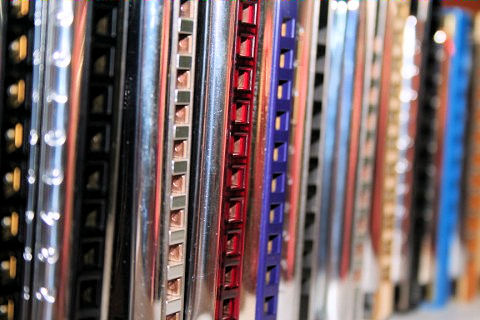 I'm not a musician: I'm just someone who likes to make
music from time to time. I hack away at it; I have since I was 14 but
for a while in my 20s
and 30s, I was very serious about playing. I don't have any real
musical talent, but I enjoy playing, and perhaps learning even more. So
this is a page for amateurs like me.
I'm not a musician: I'm just someone who likes to make
music from time to time. I hack away at it; I have since I was 14 but
for a while in my 20s
and 30s, I was very serious about playing. I don't have any real
musical talent, but I enjoy playing, and perhaps learning even more. So
this is a page for amateurs like me.
I used to play a lot - guitar, harmonica, some keyboards - lots of jams, lots of practice, and even a few gigs. For a few years after we moved up here I even used to jam weekly at the now-metamorphosed Pine Street café, back in the days when it had Sunday jams. I even managed to rise to a level of mere competence in my playing (nothing like being described as 'adequate' to encourage you to practice more!). But when I bought my business, my time evaporated. I sold my guitars, my amps, my keyboards, my pedals and effects equipment, even my motorcycle. I hung up my fishing rod. And I got even less time for playing music when I got elected to council. But I never stopped wanting to play (these days I play a lot of ukulele).
After a couple of years off abstinence, I started getting interested again. I went online and picked up flutes, native American flutes, shakuhachi, quena, and a didgeridoo. I wanted to try something different, explore something outside my experience. I really haven't put the necessary time and effort into them to really master any one of them but that hasn't reduced my enjoyment any. I recently got a Strumstick, a small stringed instrument. I'm looking at a saz, a bouzouki and an oud next... and maybe a Xaphoon (pocket sax)... but that's grist for another page. I just love to experiment.
This Spring, Susan decided to give me a gift of a new guitar - a beautiful blue Takamine 540C. Wonderful guitar with excellent sound. Slowly I've been reacquainting myself with the instrument, relearning chords, trying to remember how to play songs and riffs. And I'm getting back into the groove. My fingers hurt like hell after I play, and my calluses still have a long way to go before they're back up to their old thickness, but I'm working at it, a little bit every day. Blue because of my affinity for Wallace Stevens' famous poem.
A few months later I decided to add harmonica to my practice. I used to play a bit of blues harp, mediocre caterwauling and honking compared to masters like Carlos del Junco or John Nemeth (two of my favourite harp players) to be sure. But fun for me and a nice counterpoint to guitar. I decided to put some more effort into it this time around. I started with getting new harps - diatonic, not chromatic which is probably well above my limited skills and talent. I started buying and comparing harmonicas looking for the sound I liked the best.
Herein are my notes and conclusions (ongoing as I get and learn more). I hope they may help you make your own decisions about harmonicas. Caveat emptor: pros may have other ideas and reach different conclusions. But I don't sell anything, and I don't have any sponsorship or links with any of these companies to protect, and I bought all the harps here, so I can afford to be honest.
This is an ongoing project, and will grow as I learn more and get more harmonicas to test. I will also post some sound clips shortly, once I perfect the technology to record them at home. Update, April 04/08: I added some sound samples, using the harps below, played by me and recorded/engineered by my longtime friend, Rick Garner, a musician, engineer and teacher extraordinaire. They are short samples and I apologize for my amateur sounds.
I discovered the ukulele a month or so ago and have been having a blast learning to play. More fun than I've had in ages. A lot more expensive than harmonicas, so I can't indulge in a review like I've done here. But I'm completely taken by the sound. I've posted a few reviews of the ukes I have, here.
Comments? Want me to include something I missed? Know of harps I missed? Or links I should include? Email me: ichadwick@rogers.com
Introduction
 A good harmonica can cost as much - or more - than
an entire set of
inexpensive harps. But a good harp is probably worth the price because
it's simply a better product. The old adage is true: you get what you
pay for. But all things considered, overall harmonicas are a lot less
expensive than guitars. That's probably why there are a lot more
mediocre harmonica players like myself than there are good ones.
A good harmonica can cost as much - or more - than
an entire set of
inexpensive harps. But a good harp is probably worth the price because
it's simply a better product. The old adage is true: you get what you
pay for. But all things considered, overall harmonicas are a lot less
expensive than guitars. That's probably why there are a lot more
mediocre harmonica players like myself than there are good ones.
Unless you're a pro or have just won a lottery, you probably won't buy the full set of all 12 keys of the best harps, along with some extra minors and low keys. And frankly you'll never use half the available keys in jamming. Besides, how do you decide what is the best make to buy before you invest in the entire range?
Understanding that I needed to spend some time (and money) exploring this, I cautiously started buying one to three good harps at a time, trying different makes, keys and models so I could compare them all at once. What a long trip that's been! And don't even start on how much I've spent on this trip...
Some harps were purchased online, others through the local store, Blue Mountain Music (always shop local when you can!). However, not all manufacturers have Canadian distribution, so I've had to go to online sources for them.
The keys you need to own are all major keys: A, D, C, G, F and Bb. The Bb is for playing with horns, so it can be the last you get. I'm talking cross harp style now - playing a fourth above the key the song is in (guitar players will find this five frets up from the root note). That's blues style. So an A is for playing cross harp in the key of E, D for A, C for G, F for C and Bb for F. Got that? Good, there's a test later...
 After you have the Big Six, you can get the rest - E, B, and the flats.
Frankly most of us will normally never play in these keys but if you get
into a lot of jamming, especially with horns, you may need them if you
get that good. And some of the 'jam-along' CDs have songs in these keys,
so you may eventually want them all.
After you have the Big Six, you can get the rest - E, B, and the flats.
Frankly most of us will normally never play in these keys but if you get
into a lot of jamming, especially with horns, you may need them if you
get that good. And some of the 'jam-along' CDs have songs in these keys,
so you may eventually want them all.
You should also consider getting some of the low keys. I started with a Bushman Low F, then got a Seydel Low A, Low D and finally a LLF. These have both a different sound and require some changes in the way you play. The low notes are slower, but have a deep, rich sound almost like a bowed instrument. Keeping them in tune over the long term may, however, be a challenge.
Everything I read recommends novices start with a C harp, but I like A because it's lower. A also fits better with the blues I like to play. G is the lowest standard key, and there are new extra-low harps from some manufacturers (down to low-low F!). But if you want to play melodies and learn songs (especially if you follow along on teaching tapes or CDs), if you only get one harp, start with C because most of the basic songs are in C. It doesn't really matter later - the key (pitch) may differ but the hole positions don't change - if you're learning a song, you blow or draw the same hole no matter what the key. But you may find starting with a higher key than C makes the song sound a bit too shrill. I've also found it a little harder to control the treble notes on the higher keys, but that's probably because I'm still such a novice.
 Minor keys, Dorian tuning, augmented,
diminished, melodic tuning, circular tuning,
whole tone, tremolo, octave, spiral tuning... there are other alternatives to major
keys available, although not from every manufacturer. Seydel seems to
have the biggest list of alternatives. You're best to master the basic
major diatonic tuning first... but if you're like me you will soon want
to experiment with these other tunings and styles.
Minor keys, Dorian tuning, augmented,
diminished, melodic tuning, circular tuning,
whole tone, tremolo, octave, spiral tuning... there are other alternatives to major
keys available, although not from every manufacturer. Seydel seems to
have the biggest list of alternatives. You're best to master the basic
major diatonic tuning first... but if you're like me you will soon want
to experiment with these other tunings and styles.
Harmonica construction material is very important. I'm not sure about wooden combs any more. Plastic can be lighter, more sanitary, won't warp or swell, and is easier to clean. I have a couple of older (20 or so years) Hohner Blues Harps that have swollen combs that catch the lips and tongue uncomfortably when playing.
From everything I've read online by far better harp players than I will ever be, the comb material doesn't make a lot of difference to the sound, although there are those who argue wood is more mellow, plastic and aluminum brighter. The density of the comb material and the hole size and shape should have an effect, but I haven't read any serious study to indicate how and why.
The covers (cases), however, do matter - material and design both play a part in the resulting sound and volume. Better harps have more solid covers, with less air leakage. Air leakage is a big issue - air coming from around the reeds can affect or even distort the sound, and make it more difficult to bend notes. Heavy, thick covers also seem to make for better volume. There may also be a correlation between the distance between reed and case... but again I can't find any studies.

Here's a picture of the ends of a few harps, showing the openings and gaps in the cases. From the left: Hohner Big River, Hering Vintage 1923, Seydel Soloist Pro 12, Bushman Delta Frost, Hohner Marine Band, Hohner Special 20. The openings are largest in the Marine Band and Hering, with smaller openings in the Big River and Delta Frost. The Special 20 and Seydel have no deliberate openings like these, just gaps where the metal of the case folds over. How much these openings affect the sound is hard to say - I'd like to find a study on the nature of reed instruments and airflow that would explain whether such openings are beneficial or detrimental to the sound and volume and see the results of experiments with harmonicas to show what the results were.
Of course, the reeds make a big difference. Most companies use brass for their reeds, but Bushman Delta Frost and several Suzuki models use phosphor bronze (the same material used for some better, longer-lasting guitar stings). Bushman and Suzuki harps have a nice tone and are very responsive reeds, so I'd say their material choice works well. One company, Seydel, makes a harmonica with stainless steel reeds, the 1847, which I haven't tested yet, but the specs are impressive.
The size of the holes apparently affects volume; larger holes for a louder harp. But I've found that the comb spacing gets smaller with larger holes in some harps. For beginners, wider spacing (the plastic support between the holes) seems to make it a bit easier when learning what hole to blow.
If you want to see an animation of how harmonicas work, look at Masaru Hashimoto's Flash page (explanations in Japanese but the charts are in English).
One of the first things you'll learn is that your own hands play a vital role in the sound. How you hold the harp, how you cup it, how and when you open your hands or fingers - these all affect the resulting sound. Case design and elements like end holes seem to work in conjunction with your hands.
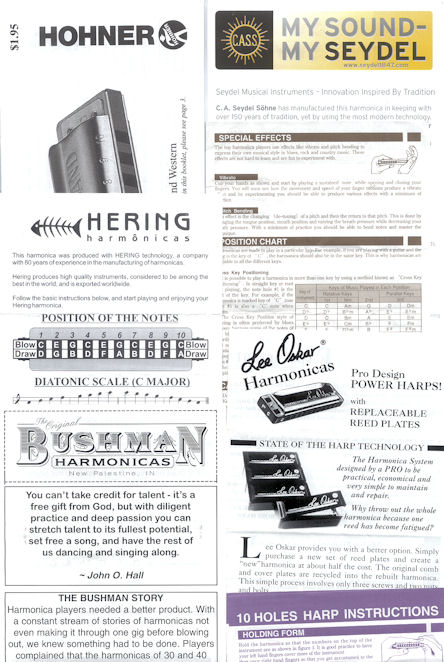 There
seems to be a good selection of quality harmonicas in the $25-$40 range. In general I've found the higher the price the better the build
quality and the better the sound. But that doesn't mean the harps will
last a lot longer: you can easily wear out the reeds by simply playing
too hard. And when you get wailing away, that's easy to do. I think I'll
be learning to do my own harp repair and maintenance fairly soon... but
fortunately many of the modern harmonicas are easy to disassemble, clean
and tweak.
There
seems to be a good selection of quality harmonicas in the $25-$40 range. In general I've found the higher the price the better the build
quality and the better the sound. But that doesn't mean the harps will
last a lot longer: you can easily wear out the reeds by simply playing
too hard. And when you get wailing away, that's easy to do. I think I'll
be learning to do my own harp repair and maintenance fairly soon... but
fortunately many of the modern harmonicas are easy to disassemble, clean
and tweak.
I've also written reviews of the Bottle o' Blues and the Egg Static harmonica mics I bought on eBay. Of course a microphone requires an amplifier, so I had to find one - something not too powerful, suitable for practice and maybe some jamming with friends. I borrowed and tested several small amps through Blue Mountain Music and finally decided on the Roland Cube 30X, which is also discussed below.
The best way to learn, in my mind, is to put on some blues CDs and play along. In fact, there are some dedicated 'play along' CDs with instrumental tracks in various chords you can work with. The little paper inserts that come with many manufacturers aren't a lot of help, but sometimes can give you some interesting background information on the companies.
There are some companies I haven't been able to sample because their products are not easily available in Canada - for example, I discovered a Brazilian harmonica company, Bends, with no North American distributor. My attempts to contact them haven't generated any responses yet, but I'll keep trying. Hering is also Brazilian, so perhaps there's a Renaissance in harmonicas going on down there. Others - like the Seydel 1847, Suzuki Pure and the Hohner XB-40 are a bit pricey and I'm not sure I can justify spending that sort of money given my amateur level of play. But being an obsessive character, I will keep looking for new harps to add.
And a final thought: my experience in buying online has been mixed and not always positive. Descriptions are not always accurate. Some manufacturers and distributors have been very fast to ship, but others have taken as many as four weeks to get items to me. I had a very bad experience with Harp Depot. eBay sellers have been average to good, but beware of excessive shipping charges (using shipping costs to help pad a low selling price). One eBay seller wanted $26 to ship a single $40 harp by mail to Canada, and another wanted $30.50 for a $10 harp! Another asked $20 for a similar harp, and a third $27.50 for a $20 harp. One online harmonica shop wanted $38-$60 to ship two harps and a belt! Others asked a more reasonable $10-$12 to ship three or four harmonicas. On the other hand, Musician's Web Store offers free shipping on orders over $99. Always check shipping costs before committing to buy on eBay.
Amplifier and microphone reviews have been moved to a separate page.
Suzuki

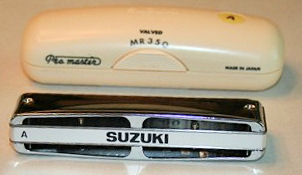 My first
major purchase after my set of Johnsons (see below) was a $45
Suzuki Promaster in A, an
all-metal harmonica with an aluminum comb - much more expensive than my
playing talents deserve. But I was intrigued by the idea of a metal comb
and wanted to hear what it sounded like, so I made the
investment.
My first
major purchase after my set of Johnsons (see below) was a $45
Suzuki Promaster in A, an
all-metal harmonica with an aluminum comb - much more expensive than my
playing talents deserve. But I was intrigued by the idea of a metal comb
and wanted to hear what it sounded like, so I made the
investment.
My first impression was, wow! What a difference after my inexpensive harps! Suddenly even my amateurish tooting sounded crisp, rich and full. I bought a second Promaster in G. Money may not buy love, but it sure can buy quality.
The harp is satisfyingly heavy and solid, the second heaviest I've purchased, after the Pipe Humming. It bends wonderfully. Smooth case that slides easily on the lips. The rear portion of the cover is supported by a central support. The reeds are phosphor-bronze, advertised as being "laser-tuned." There's a solid support for the case at the rear.
I love this harp. It's worth the cost if you're at all serious about your playing.
I was so impressed I ordered a valved version of the same harp in A, to compare it with. Valves - not to be confused with windsavers - are supposed to make overblow bends easier. Suzuki says, "Draw cycle valve system circulates air to allow note bending in the blow as well as the draw cycle. Its note bending abilities will make your music magical!" These valves are intended to let you play more notes than the standard diatonic provides. But the reviews of it online are mixed, some even negative and complain that the valves rattle or buzz. In my limited time practicing with the valved version, I didn't notice any significant improvement in playing, and find that sometimes - rarely, mind you - the valves seem to stick a bit and block the sound. Could just be my clumsy technique, however.
On the other hand, Brendan Power comments on the valved model, "A different approach to overblowing, but which is also intended to enhance the expressive and chromatic abilities of the diatonic harmonica, is to allow more notes to be bent in pitch. The Suzuki ProMaster MR350V is a half valved diatonic, which employes chromatic-style valves that work only on the lower pitched note in each air channel. This allows the lower note to be bent down in the same way as on a chromatic, giving the harp more expressiveness, while the higher notes can still be bent in the normal way. However, the valves alter the traditional breathy diatonic tone, and the valved bends are difficult to control as chromatic notes in their own right. Along with the concurrent rise of overblowing, these factors have meant that the half-valved diatonic has never achieved mainstream popularity."
When I first got my new harmonicas, I spent a couple of weeks learning to bend draw reeds again - and I think I can now do so with a modicum of ease and ability, although I still need more practice - but I've not really mastered blow bends yet (they're still sporadic and depends on the harmonica). I had hoped this harp will finally allow me to do so with greater skill. Obviously I need to work with it more to understand its subtleties. Until then, I can't find any large difference between it and the standard Promaster, either in the sound or in the bending, so I would recommend you purchase the standard model instead.
I was surprised the valved version of the Promaster weighs the same as the regular version. I had expected at least a small increase.

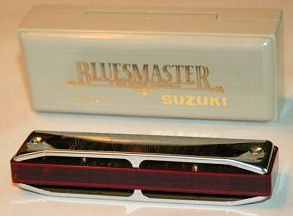 I also bought three Suzuki Bluesmaster harps, in G, F and Bb. The Bluesmaster
has as stunning a sound as the Promaster, but at a lower cost. It seems to use the same
phosphor reed plates but has a lighter plastic comb. I'd
easily buy a set of these - they're far more affordable than the Promaster.
Note the red comb on the A - C key is black to make it easier to
see in a case.
I also bought three Suzuki Bluesmaster harps, in G, F and Bb. The Bluesmaster
has as stunning a sound as the Promaster, but at a lower cost. It seems to use the same
phosphor reed plates but has a lighter plastic comb. I'd
easily buy a set of these - they're far more affordable than the Promaster.
Note the red comb on the A - C key is black to make it easier to
see in a case.
So far, these Suzuki models have impressed me the considerably - sound, comfort, bending and looks are all top notch. And the prices are comparable with other premium makes. The support at the rear of the case is, however, not as large as the Promaster, but the case is gratifyingly solid. Overall these seem the best bang for the buck in Suzuki's lineup.
I picked up a Suzuki Overdrive in A, another $60 harmonica, from eBay. This harp has a new design with rear air holes in the cover and each reed having its own chamber. It is aimed at making bending easier. It's certainly a challenge for me.
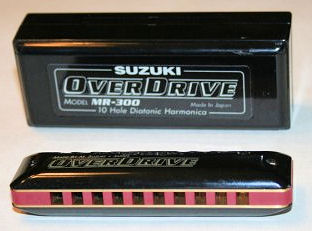 The Overdrive is also up there in weight. This model has separate
air holes at the back of the case (top and bottom, not rear) that, when you block them with a
finger, increase air flow over the reeds, supposedly making it easier to overblow and bend. The case itself has no
other back or side openings, just these 20 holes,
each one for a separate reed.
The Overdrive is also up there in weight. This model has separate
air holes at the back of the case (top and bottom, not rear) that, when you block them with a
finger, increase air flow over the reeds, supposedly making it easier to overblow and bend. The case itself has no
other back or side openings, just these 20 holes,
each one for a separate reed.
The theory sounds good - you block the upper hole to overblow (which forces air down over the lower reed and gets the upper reed to warble a bit at the same time), and the block the lower to overdraw. But that requires some coordination and practice. If you block the upper hole when drawing, you cut off the air and don't get anything! Ditto if you block the lower while drawing. And of course I've managed to block both top and bottom simultaneously... The holes are small and closely placed, so trying to figure out just where to put your fingers is a challenge. Do you just target selective holes with fingertips or use a whole finger to block several at once?
 This is obviously not a beginner's harp, although the results may prove
worth the effort in the long run. I'm not sure I have the coordination
or patience,
however. It's an interesting approach, but I'm not convinced this is the
best solution to improving overblow/draw capabilities (it's certainly
simpler than the
Bahnson solution).
This is obviously not a beginner's harp, although the results may prove
worth the effort in the long run. I'm not sure I have the coordination
or patience,
however. It's an interesting approach, but I'm not convinced this is the
best solution to improving overblow/draw capabilities (it's certainly
simpler than the
Bahnson solution).
The design also makes the Overdrive seem more muted than the standard
harp, probably because there isn't much space for the sound to expand
into or from, thanks to the sealed case.
Pat
Missin has a good page of comments and suggestions on how to play
and improve the Overdrive harp, if you're technically inclined. Pat also
points out that
Masaru Hashimoto who designed the Overdrive has a mechanical fix
(cutting the combs) that may make it even better. However, the fix
strikes as as undoing the design's intention.
One thing for sure: Suzuki is at the forefront of harmonica design with the Overdrive, Pipe Humming and other models. Almost everyone else sticks to the standard designs, while Suzuki goes out on a limb. Note that the cases on all of these models extends to the full size of the comb. I don't know if this affects the sound, or if it's just style.
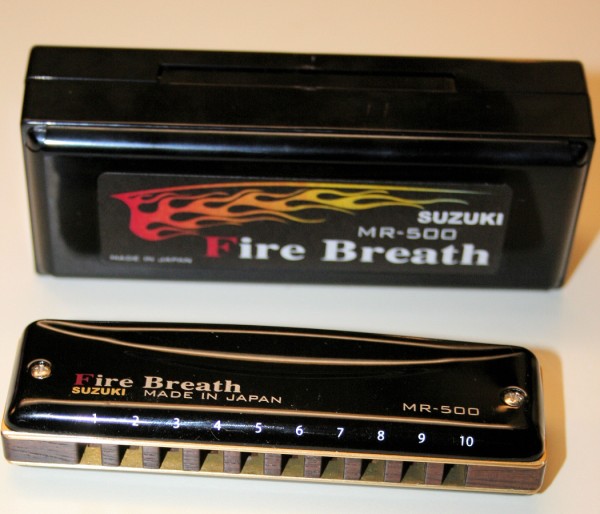 There's also a Folkmaster,
Hammond and a
Pure
Harp model from Suzuki I haven't tried (yet) but are on my wish list.
Like the other models, these are all made in
Japan.
There's also a Folkmaster,
Hammond and a
Pure
Harp model from Suzuki I haven't tried (yet) but are on my wish list.
Like the other models, these are all made in
Japan.
Nov. 6. Got a Firebreath MR-500 in low F from an online Canadian seller, Musician's Web Store. Weighty harp because it has a rosewood comb (rosewood is the most popular wood for guitar fretboards).
 Suzuki
says, "Using Rosewood can produce a high velocity of sound and a broad
range of mid and low overtones. These 'lows' help to create a complex
bottom end which imparts a richness to the overall tone to the
instrument. The re-designed reeds, which are the heart of the
instrument, have been produced with the advanced player in mind.
However, this new reed design makes it easier to play the instrument
chromatically, right out of the box! The new Suzuki Reed plates allow
ease of play, especially with overblow and overdraw techniques."
Suzuki
says, "Using Rosewood can produce a high velocity of sound and a broad
range of mid and low overtones. These 'lows' help to create a complex
bottom end which imparts a richness to the overall tone to the
instrument. The re-designed reeds, which are the heart of the
instrument, have been produced with the advanced player in mind.
However, this new reed design makes it easier to play the instrument
chromatically, right out of the box! The new Suzuki Reed plates allow
ease of play, especially with overblow and overdraw techniques."
When comparing the Firebreath with the Bushman Delta Frost LF, there is a noticeable difference in tone between the two harps. The Bushman sounds brash and louder, while the Firebreath has more low end/mid tones and sounds more muted to my ear. This is clearly what harp players mean between bright (Bushman) and warm (Firebreath) tone qualities. It's a good sound, this harp has.
The case is enamel black and supported at the back by two metal tabs,
sealed on three sides like the Pro/Bluesmaster.
There's a small indentation top and bottom along the length of the case,
which makes holding the Firebreath quite comfortable. My Firebreath had
an unusual chemical odour, possibly from the rosewood sealants, which
dissipated considerably overnight, but still lingered the next day. I
hope it goes away entirely (Nov. 14: barely noticeable now).
The Firebreath is very playable, and responsive like all the Suzukis I've tried. It's
also shorter front-to-back than their Overdrive or Pro/Bluesmaster. It
seems a little quieter than the LF Bushman, but only marginally so. It
sells for double the cost of the Bluesmaster, but I question whether a
rosewood comb is really worth the difference. Stephen Schneider says the
Firebreath (and its companion Pure Harp) are among the rare few
off-the-shelf harps that are correctly gapped, so that must contribute
to the price. It's a good harmonica, maybe even a great one, but I think
the subtleties of proper gapping are lost on an amateur like me right
now. I'll
stick to the Bluesmaster as the best buy in the Suzuki line.
Suzuki's plastic carrying cases are the best I've seen from any manufacturer. Solid, well-made, nicely lined and substantially thick. While I appreciate that quality, I would prefer a few dollars off the cost and a slightly lower-quality case instead. Lee Oskar's cases snap together - an idea Suzuki should explore.
What surprised me is that only one of the local musicians I spoke with had ever heard of - much less played - a Suzuki harmonica. I think they're missing out on an excellent instrument. I've also read some very positive comments on the Harp mailing list about Suzuki's service.
MP3 samples at 160 kb/s: Suzuki Firebreath LF, Suzuki ProMaster G, Suzuki Bluesmaster G, Suzuki Promaster Valved A. Sound samples courtesy of my longtime musician friend and music teacher, engineer and performer extraordinaire, Rick Garner.
Would I purchase another Suzuki? Yes - Promaster, Bluesmaster,
and probably a Firebreath.
Would I recommend them to others? Yes, but not likely the Overdrive.
Rating (0-5): ****1/2
Suzuki Pipe Humming
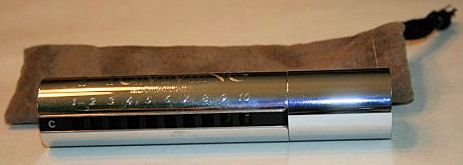
I purchased this harmonica locally, in the key of C, drawn to it because I was intrigued by the design that is either totally off the wall or the cutting edge of harp design, I'm not sure which. It's a radical departure from traditional designs. That's why the Pipe Humming harp is covered by itself on this page.
The name is baffling: what has humming to do with this instrument? Nothing more than with any other harp that I can discover.
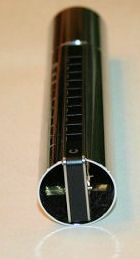 I've
spent some
time playing with the Suzuki Pipe Humming harp
- it makes some bends and some effects a bit easier than on some harps
(similar to other Suzukis I tested, though), but the pipe case makes
it larger when fitting to your lips. Not a serious problem, just takes
getting used to. I like the feel and the heft, but you have to change
how you hold a harmonica with this model. You get more lip surface area
contact with this harp - which can be good or bad depending on
how you salivate.
I've
spent some
time playing with the Suzuki Pipe Humming harp
- it makes some bends and some effects a bit easier than on some harps
(similar to other Suzukis I tested, though), but the pipe case makes
it larger when fitting to your lips. Not a serious problem, just takes
getting used to. I like the feel and the heft, but you have to change
how you hold a harmonica with this model. You get more lip surface area
contact with this harp - which can be good or bad depending on
how you salivate.
Hand position and use is equally critical, however. To really play the harp, you need to use both hands, making sure at least one end has some space to allow air in, to avoid those ghost notes. It's mostly a matter of coordination. While the design lets you have great tremolo effects, it does seem to limit some of the other effects you can get with your own cupped hands. The vibrato effect is mostly gained through fluttering the right hand.
More problematic are the design's collateral effects. When you cup one end as recommended, you restrict the air. This means the harp has to breathe through the other end of the pipe. If you also cup this end and flutter your fingers for vibrato effects, you even more seriously restrict the airflow. Draw or blow too hard and the air rushing over the other reeds (those outside your embouchure) causes them to vibrate. This air being drawn through the reeds produces 'ghost notes' as you play. This is not a good thing. I'm not sure if this can be cleaned up by improving my technique, or is insurmountable. It strikes me that small holes drilled into the case on the far side of the harp face would alleviate some of the ghost notes, without seriously affecting the vibrato effect.
I haven't figured out if the reeds can be replaced - on a $60 harp you would assume so, but I cannot see how the case can be removed from the comb. I'll have to ask Suzuki. If it can be, I might try to remove the harp, then drill some holes in the case and experiment with alternate design ideas (after I've researched some hole size/frequency questions before I start drilling...).
When played well (or as well as I can muster), the sound is as good as any Suzuki I've ever tried, but volume seems lower because the chrome pipe case cuts off the sound's travel. I tried putting it to a microphone, and found it awkward because the mic has to stick out the side - there's no other place for the sound to exit. However, the sound bouncing around inside the tube seems to create interesting overtones. It's hard to tell if the effect is just perceived or really physical (I don't have a strobe to test it) but the tone certainly sounds different from my other harps in a good way.
The round mouthpiece area makes you use your lips in a different manner than with a traditional harp. I've actually found it a little easier to slide in my mouth than other harps, I think because there's more saliva to lubricate it.
The neatest thing is the style. It simply looks sweet - a shiny chrome pipe. I suppose that's the biker in me, easily bedazzled by chrome. But it gets second looks for sure. The novelty effect is high. And you will never, ever, get one of these covers to buckle under normal wear and tear. And it comes with a funky soft suede carrying bag. I'd be really tempted to buy more if the price was lower.
 Dec.
2: I accidentally dropped the Pipe Humming harp and when I picked it
up, noticed the top portion had shifted and could be pulled off. This
got me intrigued and I quickly pulled the entire harmonica apart into three
sections: the case, its extender, and the harmonica reeds and comb. So
the reeds can be replaced - the reed plates appear to be stainless steel
like the Promaster, with similar brass or phosphor-bronze reeds, but I
haven't taken my other Suzukis apart to compare them. The harp part is
held in by simple pressure. You can also play
it with the extension removed.
Dec.
2: I accidentally dropped the Pipe Humming harp and when I picked it
up, noticed the top portion had shifted and could be pulled off. This
got me intrigued and I quickly pulled the entire harmonica apart into three
sections: the case, its extender, and the harmonica reeds and comb. So
the reeds can be replaced - the reed plates appear to be stainless steel
like the Promaster, with similar brass or phosphor-bronze reeds, but I
haven't taken my other Suzukis apart to compare them. The harp part is
held in by simple pressure. You can also play
it with the extension removed.
MP3 samples at 160 kb/s: Suzuki Pipe Humming C. Sound samples courtesy of my longtime musician friend and music teacher, engineer and performer extraordinaire, Rick Garner.
Would I purchase another Pipe Humming? Probably
not but I'm waffling (it's the chrome pipe...).
Would I recommend them to others? Yes, with caveats.
Rating (0-5): ***
Seydel

Based on some very positive comments on the Harp-L mailing list, I ordered three Seydel harps. Seydel is the oldest harmonica maker in Germany, but their harps were not readily available in North America until recently. Rupert Oysler is the Seydel USA rep and he's really been quite quick to fulfill orders.
The Seydel website has a lot of choices on it, and you can get quite lost trying to figure out what they offer, and which would suit your needs. Seydel provides PDF catalogues and spec sheets which certainly help. However, the sheer diversity is overwhelming.
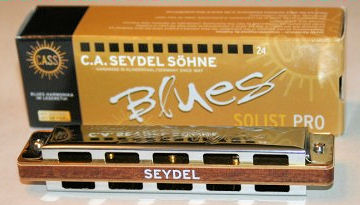 One of the harps I got is a 12-hole harp (Soloist Pro
12) in Low A. This 12-hole design adds a low octave to the normal harp,
but also drops the high notes from the other end (the last hole on a
standard diatonic is missing).
Interesting... really low harps are difficult to make and play, but
sound wonderful in a master's hands. Sure, it squeaks and honks in mine,
but the low sound is truly stunning when I get it right. It requires a
little extra care not to overblow or overdraw those low notes too much.
This is apparently the same tuning as Hohner's 365 Steve Baker
Special harp.
One of the harps I got is a 12-hole harp (Soloist Pro
12) in Low A. This 12-hole design adds a low octave to the normal harp,
but also drops the high notes from the other end (the last hole on a
standard diatonic is missing).
Interesting... really low harps are difficult to make and play, but
sound wonderful in a master's hands. Sure, it squeaks and honks in mine,
but the low sound is truly stunning when I get it right. It requires a
little extra care not to overblow or overdraw those low notes too much.
This is apparently the same tuning as Hohner's 365 Steve Baker
Special harp.
The 12-hole harp gives more notes to work with, but it requires a little bit of thought because it adds notes on the left, so you have to think about what notes you're blowing if you are trying to play a memorized tune. It also has a wooden comb which seems to be sealed from any potential swelling. Hohner and Hering both offer 12-hole harps I'd like to get to compare this Seydel against.
Notice the numerous struts on the Soloist 12 to keep the back cover up. This harp is both long and heavy, perhaps a trifle too short for the supplied leather sleeve, and it won't fit in the same case slot as a standard diatonic. But the Pro 12 is still small enough to comfortably fit in my hands, so I can cup it reasonably well. This harp has become a personal favourite over the last month and I find I play it more often than any other harp I own because I like the range it offers.
The Soloist Pro also has larger than average holes. it's a bit difficult to see from the photo, but they're cut with a bulge to the sides so they appear somewhat oval. Seydel says this: "The wooden body is ground in two planes around the mouthpiece, so that the hole openings have an oval shape. At the same time, the front fits better to the lips, so that airloss becomes less. With careful rounding of the dividers at the hole entrances, the kind of lip care is achieved that is usually only possible with plastic."
Seydel is the only one that provides a leather sleeve for its harps, which if not as protective as the plastic shells, is smaller, lighter and very attractive. All Seydels come in a cardboard box, with the harp, cleaning sheet and a leather carrying case in the box.
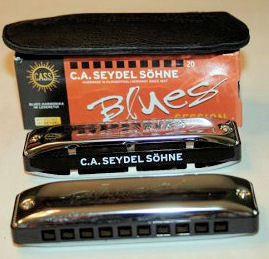 I also bought two Blues
Session (Low D and C) from Seydel. The Low D is almost as nice as
the
Low A, giving me nice, low, sultry sounds, almost like stringed/bowed
sounds on the lowest keys. The Blues Session have plastic combs,
and three struts to support the rear of the case. Rupert tells
me the Seydel Favorites are similar but even better yet - they
have an aluminum comb like the Promaster. I'll have to buy one
to test in a future order with Seydel.
I also bought two Blues
Session (Low D and C) from Seydel. The Low D is almost as nice as
the
Low A, giving me nice, low, sultry sounds, almost like stringed/bowed
sounds on the lowest keys. The Blues Session have plastic combs,
and three struts to support the rear of the case. Rupert tells
me the Seydel Favorites are similar but even better yet - they
have an aluminum comb like the Promaster. I'll have to buy one
to test in a future order with Seydel.
I liked the low keys so much I ordered Seydel's very lowest key as well: the Low Low F (LLF). Listen to the sound sample of the LLF on the Seydel USA site and you'll hear why this excites me. It doesn't even sound like a harmonica, more like a cello. Maybe pro harp players won't care as much, since the use must be limited, but for me the sound is everything. I think it could be a meditative sound, like a bass shakuhachi.
You can see from the photos that the Soloist Pro, above, is designed much like the traditional harp - the 'boxcar' shape - while the Sessions have cases more like Suzuki, extending to the edge of the comb. Personally I like this 'modern' design better. Seems more ergonomic. I'm sure this design has different airflow patters than the traditional case - but can't say what that means to the sound or tone.
So far these Seydels have really impressed me and are at the top of my list of favourites. They are very well made, have a great sound, are highly playable, and come well-packaged.
Seydel may not be experimenting with case design as much as Suzuki, but they certainly have a lot more tunings than anyone else I've seen, as well as offering custom tuning, opening up whole new vistas for experimentation. I ordered a couple of what I considered unusual tunings (Session models augmented and Dorian), to play with.
Oct 29: Got the newest Seydels. The Dorian is an interesting tuning, somewhat like a minor and I think I can probably use it as such. I actually like it - the chords sound like those used in the theme from the Odd Couple movie/TV series. It's playable in third position as a blues/cross harp, but with some different notes in the mix. Very nice! Nov. 26: I liked this so much I ordered a second Dorian in A, as well as a circular tuning.
The augmented tuning - well, it's just downright odd. For me, that is. Not sure if I'll ever actually play it with anything, very strange sound like a B-movie horror soundtrack... the Seydel site says: "Concept is to be able to play full chromatic scales solely using Drawbends to reach the missing notes. The chords behind sound a bit Oriental or Spanish." Obviously it's for more advanced players than I am - everything I try to play sounds like I keep hitting the wrong note!
The LLF is a bit problematic and patience is required. The reeds are larger and heavier than a standard harp, so they require more care for blowing and drawing and do not respond as quickly. Both reeds in my first hole also stick a bit, and quite often they simply don't produce any sound. I've been gently working them by breath alone to try and loosen them up, but they still work only erratically. Rupert has given me some tips should I decide to remove the cover and attempt a mechanical fix. When it does work, the low reeds sound like a didgeridoo! I wouldn't recommend the ultra-low harps for beginners like myself - pros may be used to these vagaries of harmonicas, but amateurs like me may find them frustrating.
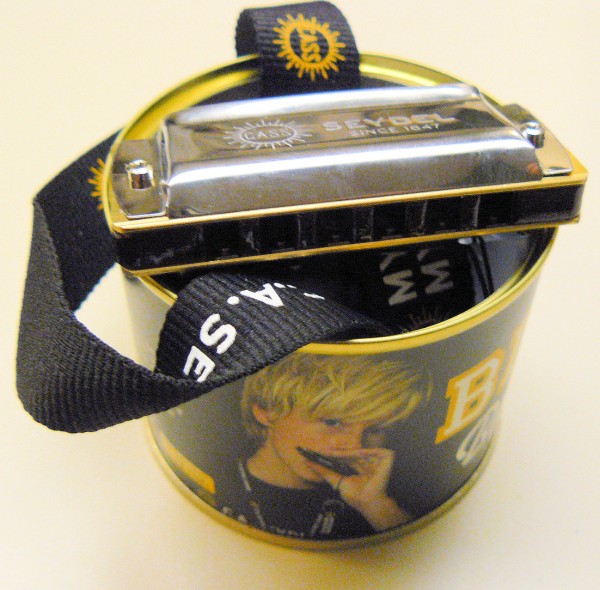 Nov. 16: After a couple of weeks, the LLF lowest keys
doesn't stick as often, but it's still not entirely free.
Nov. 16: After a couple of weeks, the LLF lowest keys
doesn't stick as often, but it's still not entirely free.
Dec. 11: Got a circular tuning Session harp. Again, it's one of those challenges: it requires re-learning some of the techniques and the chords simply aren't the same as on a diatonic. You can reach a lot more notes, but I find I have to play it like I type - hunt and peck, because I'm not accustomed to what the holes produce yet. More later once I've had the chance to practice more with it. It's the usual Seydel quality and sound.
Dec. 18: Finally got the Big Six (blues version) harp in C: a mini-harmonica
with six holes using the same stainless steel reeds that the
1847 harp uses. Small size, but feels much larger than the Puck
because the holes are much larger, although they're similar in
length. It comes in a can, which is a
cute
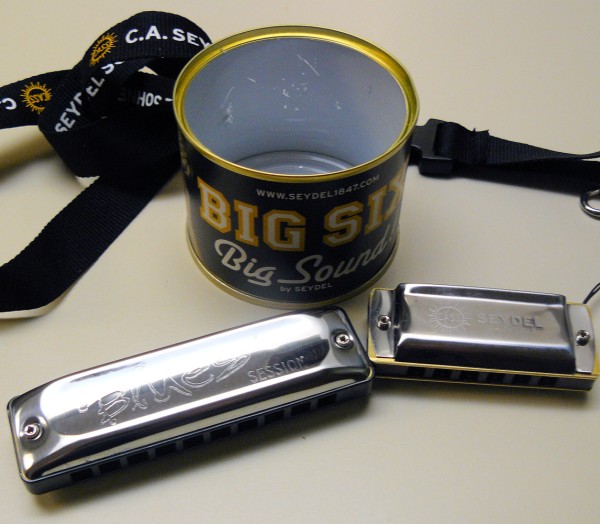 marketing ploy. It also comes with a lanyard so you can
wear it around your neck. This is an interesting idea - instead
of a harp belt you could hang several harps around your neck -
but how to attach them? It doesn't come with any sort of case
except the can.
marketing ploy. It also comes with a lanyard so you can
wear it around your neck. This is an interesting idea - instead
of a harp belt you could hang several harps around your neck -
but how to attach them? It doesn't come with any sort of case
except the can.
The comb is wood, and the case lacks any rear supports, although it seems pretty sturdy.
This seems more of a novelty item, but it plays very well (much more easily than the Puck and far less shrill). It might be the perfect harp to introduce young players to the instrument, although at the price you can get some pretty good 10-hole diatonics instead. I can't yet tell if the stainless steel reeds make any difference, so I'll have to experiment more over the weekend. There's also a 'folk' version which from the description appears to be a circular tuning. It's cute, and sounds good, but the lack of a range of keys as well as the price make me hesitate to recommend it.
MP3 samples at 160 kb/s: Seydel Soloist Pro A, Seydel Big Six C, Seydel Blues Session Low D, Seydel Blues Session Low F, Seydel Blues Session Dorian G. Sound samples courtesy of my longtime musician friend and music teacher, engineer and performer extraordinaire, Rick Garner.
Would I purchase another Seydel Yes (all models tested, but not an augmented tuning or Big Six).
Would I recommend them to others? Yes, but the
ultra-low keys with a caveat.
Rating (0-5): *****
Bushman

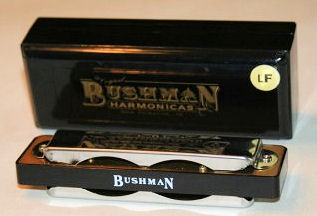 I
started with a Bushman Delta Frost Low F, which is one whole note
lower than the standard G harp. The Bushman reeds have
the same easy and bright responsiveness as the Suzukis, perhaps even
a little more. Light reeds, easily bent, plenty of
volume - on first impressions, I really liked it. But I think I liked the lower
key most of all. This was my first low-key harmonica and I
carried it around with me for several days just to play that low register.
Low notes just seem so expressive, so earthy...
I
started with a Bushman Delta Frost Low F, which is one whole note
lower than the standard G harp. The Bushman reeds have
the same easy and bright responsiveness as the Suzukis, perhaps even
a little more. Light reeds, easily bent, plenty of
volume - on first impressions, I really liked it. But I think I liked the lower
key most of all. This was my first low-key harmonica and I
carried it around with me for several days just to play that low register.
Low notes just seem so expressive, so earthy...
Then I ordered a Delta F class="leftimage"rost Bb and D, as well as a Bushman Soul's Voice Dm natural from the source. The Soul Voice uses traditional brass reeds instead of the phosphor-bronze of the DF. The Soul's Voice was out of stock at Bushman and arrived Nov 13. I wanted to compare it against the Lee Oskar minors. All of these harps lived up to the high standard set by the Low F.
Note the large supports for the case, too. This is a solid harp with big sound.
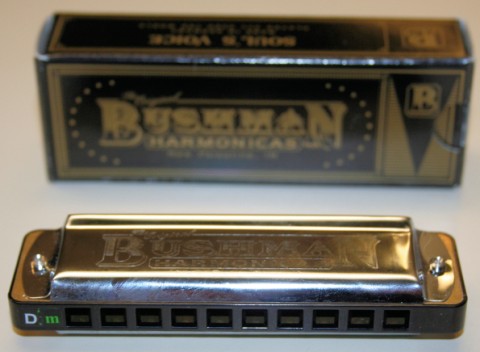 The Bushman is another modular system harp,
with replaceable reeds, and a solid build. The
rear cover has three supports. It's a bit blockier than the more
rounded Suzukis. The key here is that the Delta Frost uses
phosphor-bronze reeds, which Bushman claims will last longer and
play better. I can't speak for the longevity, but the
responsiveness of the reeds is impressive.
The Bushman is another modular system harp,
with replaceable reeds, and a solid build. The
rear cover has three supports. It's a bit blockier than the more
rounded Suzukis. The key here is that the Delta Frost uses
phosphor-bronze reeds, which Bushman claims will last longer and
play better. I can't speak for the longevity, but the
responsiveness of the reeds is impressive.
Bushman even offers extra-low keys in their Soul's Voice harps. The physics of harmonicas means larger, longer reeds are used for lower notes. But those longer reeds provide some design challenges, as well as some playing challenges. I'll have to order a low key in the SV to test this winter.
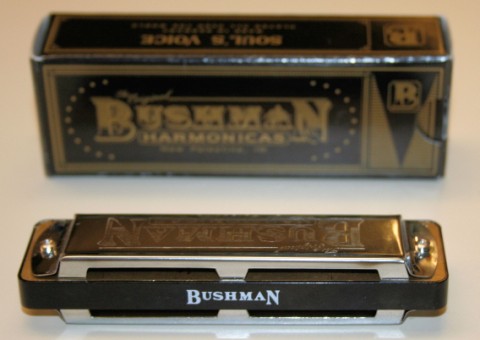 Bushman reeds sound bright and feel responsive, comparable to the
Suzuki Bluesmaster/Promaster harps. I've been very happy with my
Bushmans, but I've been told they are often difficult to get and out of
supply for weeks at a time. I'm not sure where they are actually made.
Bushman reeds sound bright and feel responsive, comparable to the
Suzuki Bluesmaster/Promaster harps. I've been very happy with my
Bushmans, but I've been told they are often difficult to get and out of
supply for weeks at a time. I'm not sure where they are actually made.
Bushman also makes an inexpensive line of harmonicas called 'Blue Steel.' Although I didn't test these, I was suspicious that they looked far too similar to the Merano and Johnson harps. At $2.95 each they are among the least expensive I've seen, but I still wouldn't try them given my poor experience with Meranos. However, the 12-harp case seems like a good item for the price of the set, so maybe you can get it and give the harps to a young kid anxious to learn.
Nov. 14: Played the Soul's Voice a bit last night. It's a nice harp, not as bright or as responsive as the Delta Frost, but I had no problems playing or bending notes. Compares well with the Hohner and Lee Oskar. Uses standard brass reeds.
Well-made and solid, with supporting metal tabs at the rear of the case. Comes in a cardboard box, not the nice plastic case of the DF. Weighs the same as the DF. I got a Dm natural tuning, which presents its own challenges. I will probably get a major key to try in the near future, but I personally liked the DF a lot more.
MP3 samples at 160 kb/s: Bushman Delta Frost Bb. Sound samples courtesy of my longtime musician friend and music teacher, engineer and performer extraordinaire, Rick Garner.
Would I purchase another Bushman? Yes (Delta Frost for sure).
Would I recommend them to others? Yes.
Rating (0-5): ****1/2
Lee Oskar
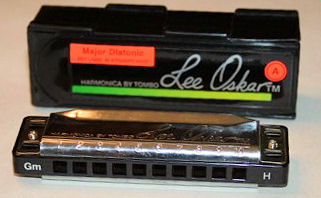
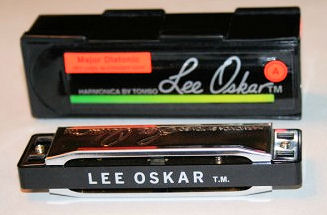 I
bought my first Lee Oskar in F, locally again, for about $40.
This one's a bit brighter than a Hohner Marine Band, closer
to the Special 20 and Big River, and seems to bend a bit more
easily than the Marine Band.
I
bought my first Lee Oskar in F, locally again, for about $40.
This one's a bit brighter than a Hohner Marine Band, closer
to the Special 20 and Big River, and seems to bend a bit more
easily than the Marine Band.
Plastic comb. I like the way the harp feels on the lips better than the Hohner Special 20, but that's minor. Lee Oscar uses a plastic support for the cases at the rear.
A lot of musicians seem sold on Lee Oskar's harps. They use a modular system that lets you replace worn out reed plates. And the quality is certainly good. Sound is good, too, very similar to the Special 20. Lee Oskar harps are made in Japan by Tomba.
I also got a Lee Oskar Am Natural and one in Gm harmonic tuning. Minor harps are a whole other adventure and I really shouldn't wander down that road until I've got the majors worked out more. But the minor keys sound hauntingly good.
The Gm in harmonic tuning is quite different from my Am in natural tuning. The Am sounds more soulful, while the harmonic tuning is described as 'ethnic.' Just playing a little bit, it reminds me of accordion music, maybe something Parisian or Eastern European, and also somewhat mournful. Very odd sound (for a talentless player with limited musical experience like myself), but yet also very appealling tuning. Can't think of what I'll be able to play along with... but I like what I hear playing solo. I'll likely get another harmonic minor in a different key, perhaps Em.
Lee Oskar is one of the pioneers of the modular system and for musicians who go through a lot of reeds, it's cheaper to replace reed plates than buying a new harmonica. Another neat thing: the cases lock together and several can be carried together as one (a piece of tape on the bottom helps keep them from slipping apart).
Among local musicians, Lee Oskar seems either the preferred choice or a close second after Hohner, but in part I'd suggest that's more due to a lack of easily available options (no one sells Suzuki, Seydel, Bushman locally although Suzuki can be ordered).
MP3 samples at 160 kb/s: Lee Oskar Gm harmonic, Lee Oskar Am natural, Lee Oskar A. The last one was done through the Bottle O Blues mic. Sound samples courtesy of my longtime musician friend and music teacher, engineer and performer extraordinaire, Rick Garner.
Would I purchase another Lee Oskar? Yes.
Would I recommend them to others? Yes.
Rating (0-5): ****
Hohner

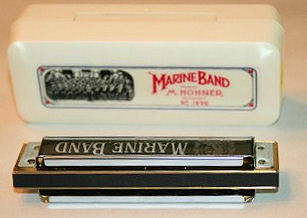 The
Hohner
Marine Band is an old standby, and still one of the most popular
harps sold today, and easily the most well-known harmonica maker.
Once upon a time when you talked harmonicas, you talked Hohner.
For a long time it was a choice between a Hohner and some cheap
knockoff. Hohner seemed to get fairly complacent in both
manufacturing and marketing. There are a lot more choices today,
and since the mid-1990s Hohner has had to pull its socks up and
become a lot more competitive and creative.
The
Hohner
Marine Band is an old standby, and still one of the most popular
harps sold today, and easily the most well-known harmonica maker.
Once upon a time when you talked harmonicas, you talked Hohner.
For a long time it was a choice between a Hohner and some cheap
knockoff. Hohner seemed to get fairly complacent in both
manufacturing and marketing. There are a lot more choices today,
and since the mid-1990s Hohner has had to pull its socks up and
become a lot more competitive and creative.
The MB has a good tone, a bit more mellow than the Promaster, and much lighter (the Hohner uses the traditional wooden comb), but a good, solid sound that others often measure against. Not quite as loud or bright as the Suzukis, but very playable. I got this locally for about $35.
Many pros swear by these harps (Kelly 'Mr. Chill' Hoppe, also of Big Sugar, plays only Marine Band Deluxe harps and says he likes the wooden comb), but there are a lot of newer companies with competing products. My only concern has always been with the lack of a read support for the cover. This is one harp you don't want to put in your back pocket and sit down on it, because the cover can bend. Take my word for it...
Or take this word from another site: "For more than than 100 years, the Marine Band has been the favourite mouth organ of artists same Little Walter, Paul Butterfield and Kim Wilson. Ever because that 1896, discreet pro harp players in look of an clear and uncommon go feature played the Hohner Marine Band as their instrumentate of prime." How can I top that description?
I don't find the Marine Band's reeds as responsive as the Suzuki and some other harmonicas, but there's an obvious trade off in tone, and responsiveness seems to mean brighter tone. When I say responsive, I mean how much air is required to get sound from the reeds. To me, a more responsive harp requires less air. But the Hohners are still a lot better than any inexpensive harp and its 'warm' tone has set the standard for many years. Besides, they're available just about everywhere. Steve Harvell has another take on the MB, but I don't agree with his conclusions.
Most of the Hohner harps I've seen have the traditional 'boxcar' shape (with little 'ledges' on the sides). Lots of other companies emulate this, but a few branch off and have created alternate cases, more ergonomic, and stylish. How much the case shape and size affects the sound is hard to tell.
Another thing you see on some of these Hohners is a small slot or opening on the sides of the case. Again, it's a mystery how and why these holes affect the sound, aside from ensuring air comes from the sides when playing - but how this might affect the reeds or volume, that's another area I can't speak to until I find some convincing research (read the sidebar on the left for Stephen Schneider's comments on these holes).

 I also
got a Hohner Special 20 in D from the same
local store. The only real
difference seems to be in the Special 20's plastic comb and lack of side
openings. They're
similar in price to the Marine Band. That plastic comb adds a
small amount of weight to the harp (3g) compared to the Marine
Band, but nothing
significant. Me, I like a heftier harp. I think the cover is a
bit sturdier and less likely to buckle under weight because of a
plastic tab that extrudes from the comb on both sides at the
rear of the case.
I also
got a Hohner Special 20 in D from the same
local store. The only real
difference seems to be in the Special 20's plastic comb and lack of side
openings. They're
similar in price to the Marine Band. That plastic comb adds a
small amount of weight to the harp (3g) compared to the Marine
Band, but nothing
significant. Me, I like a heftier harp. I think the cover is a
bit sturdier and less likely to buckle under weight because of a
plastic tab that extrudes from the comb on both sides at the
rear of the case.
My sole Special 20 seems to have blown a reed within the first two days of owning it (the 4 draw), so I can't say I'm impressed with this harp. I'm not that hard on these things and this is the only one of almost three dozen new harps to do this. I hope this isn't an example of the typical build quality. But that alone makes me shy of buying more. I may try to repair it this winter. See the note on the TurboHarp Turbo 20, below.

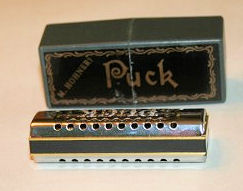 The Hohner Puck
is a miniature 10-hole harmonica in C I got from eBay. It's small,
shrill, and the reeds squeak at the upper end. Seydel offers a four-hole mini -
which seems to be full-sized reed and holes, just fewer of them.
I might get one to compare minis, but their use seems limited. I can't
see anyone playing a Puck aside from the novelty. What I found
interesting about the Puck was its cover design - it seems designed to
hold in the sound, rather than let it out. Made in China, plastic comb.
Hohner also makes a small Piccolo harp (wooden comb) that musicians seem
to consider more playable than the Puck.
The Hohner Puck
is a miniature 10-hole harmonica in C I got from eBay. It's small,
shrill, and the reeds squeak at the upper end. Seydel offers a four-hole mini -
which seems to be full-sized reed and holes, just fewer of them.
I might get one to compare minis, but their use seems limited. I can't
see anyone playing a Puck aside from the novelty. What I found
interesting about the Puck was its cover design - it seems designed to
hold in the sound, rather than let it out. Made in China, plastic comb.
Hohner also makes a small Piccolo harp (wooden comb) that musicians seem
to consider more playable than the Puck.
As one web site describes the Puck: "The Hohner Puck Harmonica is a high-pitched character petite harp according to untainted nerve covers and pliant combs in favor of a lifetime of playing. Less than iii inches protracted, the Hohner Puck harp is little plenty to insert into regular the smallest shirt bag, spell noneffervescent workmanship a really heavy Hohner go! Comes in a tough pliant caseful."
 Noneffervescent workmanship, indeed! Perhaps you might want to get
something made with effervescent workmanship instead...
Noneffervescent workmanship, indeed! Perhaps you might want to get
something made with effervescent workmanship instead...
 I think the Hohner Big River has effervescent workmanship however...
it's a less expensive cousin to the Special 20, but I think it sounds
and plays a bit better... certainly better than my Special 20
which had a reed go sour within 48 hours (I suppose I can try to fix it
but I shouldn't have to this early on, so it tainted my appreciation of
Hohners). I picked up a Big River in G locally for about $25.
I think the Hohner Big River has effervescent workmanship however...
it's a less expensive cousin to the Special 20, but I think it sounds
and plays a bit better... certainly better than my Special 20
which had a reed go sour within 48 hours (I suppose I can try to fix it
but I shouldn't have to this early on, so it tainted my appreciation of
Hohners). I picked up a Big River in G locally for about $25.
The one thing I don't like about the Big River is that the reed plate protrudes slightly over the comb, whereas with the Special 20, it is inset in the comb. But for the difference in the price, the Big River seems a better choice. Personally, I felt the reeds were a bit more responsive than the Special 20, too.
The Big River has a plastic comb, the case is propped up with four struts at the back, plus a single plastic 'thumb' that extrudes to the top half of the case. Not sure why there isn't a second piece supporting the bottom half, but perhaps it wasn't necessary, with the case supports being there to protect it. This harp is a bit heavier than both the Marine Band and Special 20.

 Buried in a drawer I found a couple of 20+ year-old Hohner
Blues harps. These are basically the same as the Marine Band. One needs serious resuscitation
(and may be beyond repair), but the other is
serviceable. First thing I noticed is how the wooden comb has
swollen, which struck me as a point in favour of metal or
plastic combs. Wooden combs swell and can protrude, catching the
lips uncomfortably as you play. I don't believe there is any
real difference between the Blues Harp and the Marine Band, aside
from the packaging. You can see that the cover of my older Blues
Harp has bent, probably from sitting on it - like the Marine
Band it lacks any support to keep the case up. Time to buy one or
two new ones. I used to really like these harps, but back when
they were new Hohner was just about the only game in town.
Buried in a drawer I found a couple of 20+ year-old Hohner
Blues harps. These are basically the same as the Marine Band. One needs serious resuscitation
(and may be beyond repair), but the other is
serviceable. First thing I noticed is how the wooden comb has
swollen, which struck me as a point in favour of metal or
plastic combs. Wooden combs swell and can protrude, catching the
lips uncomfortably as you play. I don't believe there is any
real difference between the Blues Harp and the Marine Band, aside
from the packaging. You can see that the cover of my older Blues
Harp has bent, probably from sitting on it - like the Marine
Band it lacks any support to keep the case up. Time to buy one or
two new ones. I used to really like these harps, but back when
they were new Hohner was just about the only game in town.
I really have to try out a Hohner XB 40... I've been reading all about if for months now. But because of its price (about $100) I tried their Golden Melody harp first (Carlos del Junco uses these harps exclusively on his latest album, so I ordered one). I finally broke down and ordered an XB-40 from an eBay seller - a big investment (with shipping almost $100) for a single harp for a guy with my lack of talent (arrived Nov. 20, see below).
I'm also interested in comparing the Hohner Meisterklasse with the Suzuki Promaster (both have aluminum combs).
 Because this is a big
company, Hohner offers a wide range of products, including some inexpensive
harps. Unless you're an absolute novice or you're buying for children, I don't recommend the
lower-priced lines from any company, and I tend to shy away from
anything inexpensive made in China on principle (and experience). I suggest you stick to the mid-to-upper range
because they are better made, sound better and last longer. Put out a
little bit more money and get a lot more instrument in return.
Because this is a big
company, Hohner offers a wide range of products, including some inexpensive
harps. Unless you're an absolute novice or you're buying for children, I don't recommend the
lower-priced lines from any company, and I tend to shy away from
anything inexpensive made in China on principle (and experience). I suggest you stick to the mid-to-upper range
because they are better made, sound better and last longer. Put out a
little bit more money and get a lot more instrument in return.
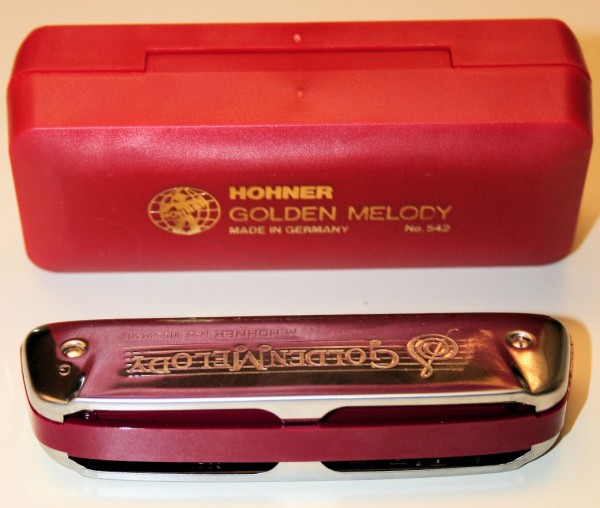 Nov.
6. Got a Hohner Golden Melody in G yesterday from Musician's
Web Store. Banana-style shape, although the reed plate is actually
rectangular and doesn't extend to the full size of the comb at the rear
(which makes me wonder if it's the same plate as another Hohner harp).
Nov.
6. Got a Hohner Golden Melody in G yesterday from Musician's
Web Store. Banana-style shape, although the reed plate is actually
rectangular and doesn't extend to the full size of the comb at the rear
(which makes me wonder if it's the same plate as another Hohner harp).
Case is supported by large metal struts. Very playable - like the Big River it seems more responsive than the Marine Band, but a little quieter than the Big River. I think the rounded shape allows the player better hand coverage than the boxcar design. I think it plays the best of all the Hohners I've tried so far. Carlos Del Junco plays them on his latest album, although not likely stock versions (and apparently has a Low Eb, which I can't find listed anywhere).
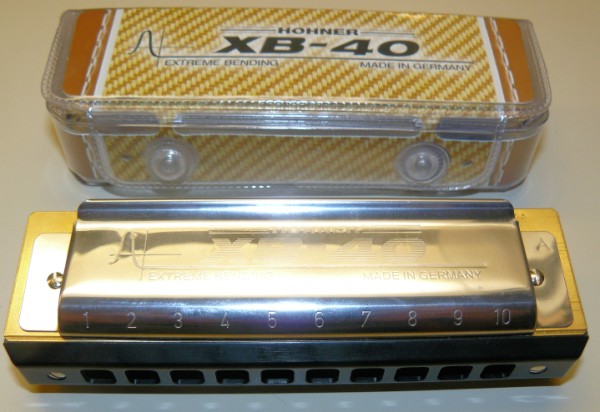 Nov. 20: The XB-40 arrived today. What a big harp! The sheer size
is a little intimidating, like buying an XXL shirt for a medium-sized
body or driving a Hummer after my Echo Hatchback. This looks like a challenge... first few test blows/draws created
a range of odd and unexpected sounds. Not bad, just those 'did I do
that?' sort of sound. I have my evening's fun set out...
Nov. 20: The XB-40 arrived today. What a big harp! The sheer size
is a little intimidating, like buying an XXL shirt for a medium-sized
body or driving a Hummer after my Echo Hatchback. This looks like a challenge... first few test blows/draws created
a range of odd and unexpected sounds. Not bad, just those 'did I do
that?' sort of sound. I have my evening's fun set out...
Case is supported by a slim metal tab at the back - seems a bit small for the size of the harp, but the cover feels solid. The comb looks like it's made of two combs stacked together. At 106g, this harp is the second heaviest I've tested, after the Suzuki Pipe Humming.
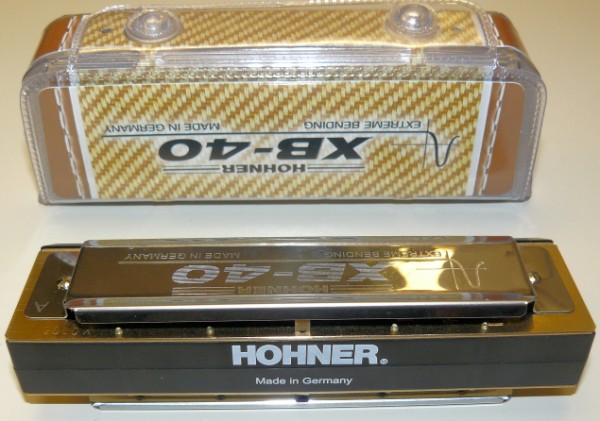 Not
sure what to make of it. It sounds different from every other harp I
have. Not very loud or bright - which seems surprising for its size.
You'd expect something this big to shout, and it doesn't. I seem to hit
wrong notes rather frequently and I think that's because it bends so
easily. You automatically want to play it loud and hard because it seems
like a big harp demands it, but it's a lot more subtle than that.
Not
sure what to make of it. It sounds different from every other harp I
have. Not very loud or bright - which seems surprising for its size.
You'd expect something this big to shout, and it doesn't. I seem to hit
wrong notes rather frequently and I think that's because it bends so
easily. You automatically want to play it loud and hard because it seems
like a big harp demands it, but it's a lot more subtle than that.
It also feels very different in the hand because of its size. I find it
a bit awkward to hold, but you get used to it after a short while.
 This
harp will take me some serious experimentation to find its soul. I think
I'm in over my head because it's clearly designed for skilled musicians
and not mere honkers like myself. Maybe it will inspire me, or simply
frustrate me. I am still trying to learn the basics and this harp needs
me to learn sophisticated techniques. At the moment, I can't recommend
this for beginners simply because it's both quite different and very
expensive.
This
harp will take me some serious experimentation to find its soul. I think
I'm in over my head because it's clearly designed for skilled musicians
and not mere honkers like myself. Maybe it will inspire me, or simply
frustrate me. I am still trying to learn the basics and this harp needs
me to learn sophisticated techniques. At the moment, I can't recommend
this for beginners simply because it's both quite different and very
expensive.
Nov. 23. The XB-40 is definitely not for novices like me. It has a wide range of notes with bending, but I can't seem to reach some of them consistently. In fact, some of the notes seem to overdraw too easily and sound off-tune. Sometimes the reeds sound jangly or buzzy - probably I'm playing it harder than necessary but I don't think I'm doing anything I don't do with other types of harmonica. Obviously it's something you need to practice diligently on. Yet it intrigues me and I'll keep trying to make it sound better.
Dec. 18: The XB-40 its sounding better, but still a way to go. It has a sort of honking, sax-like sound at times. One thing I've noticed that's different from other harmonicas is that, when you play the others, the reeds continue to vibrate for a short while after you've stopped blowing or drawing. With the XB-40, they stop immediately when the air pressure is removed. Must be the valve system that does this.
MP3 samples at 160 kb/s: Hohner Golden Melody G, Hohner XB40A, Hohner Special 20 D, Hohner Big River G. Sound samples courtesy of my longtime musician friend and music teacher, engineer and performer extraordinaire, Rick Garner.
Would I purchase another Hohner? Yes: Golden Melody, Big River and Marine Band
in that order
(not Special 20 or Puck).
Not another XB-40 yet, until I'm a lot better.
Would I recommend them to others? Yes (not
Special 20 or Puck). XB-40: not for beginners.
Rating (0-5): ***1/2
Hering

I bought two Hering harps - the Vintage 1923 models - on eBay because I read that they were designed like the old harmonicas of the past and that apparently made a difference. At least some people seemed to rave about them.
They're Brazilian-made harps with a wooden comb, vintage-looking brass covers, heavy in the hand. I picked up keys E & B. Odd keys, I know, but I am collecting harps in every key so as to not end up with a collection of just a few popular keys.
My first impression: they're quite similar to the Marine Band sound but heavier in the hand. Nice feel, but maybe not as air tight as I'd like, nor nearly as responsive as the Suzuki or Bushman. I have a bit of trouble bending some of the notes and a couple of the reeds seem to stick. As a result, these Herings won't get a lot more play until I can open them up and perhaps free the sticking reeds.
 Seems to be a bit of
a metallic taste in the mouth, too from the brass, but that may
vary with the acidity of the player's saliva. This may wear
off. I've read the
wood is treated so it won't swell.
Seems to be a bit of
a metallic taste in the mouth, too from the brass, but that may
vary with the acidity of the player's saliva. This may wear
off. I've read the
wood is treated so it won't swell.
I would like to try a G or A, something lower in key to see if I appreciate these a bit more. But I'm a little cautious about spending a lot more money on a harp that doesn't strike me as a premium product.
Hering also has side slits on its covers, like the Marine Band. There is no support for the case at the rear (again like the MB), but the covers seem thicker than usual, so perhaps they'll hold up better than the Marine Band. These harps look better than they play, at least the pair I got.
Finding Hering harps is problematic: doesn't seem to be a Canadian distributor, but the company has ignored all my emails asking about it. I've tried to order a couple of different models from The Instrument Store, an American online seller (Master Blues and Black Blues) to compare with these two, but although their web site still advertises Hering harps, the company told me later they stopped carrying them. Still trying to find a source. Most online sellers who list them want far too much in shipping to make it work the cost to try more.
Would I purchase another Hering? No.
Would I recommend them to others? No.
Rating (0-5): **1/2
Harmonix
 Nov 13:
I just got a Harmonix modular harmonica (C), with two additional
reed cartridges (G and Bbm) from an eBay seller. Very odd looking duck, with a
convex mouthpiece that has rectangular holes with rounded
corners. The main unit is quite bulky because it's designed to hold an
integral wireless microphone (which I didn't order). I'll write it up and post pictures
shortly, along with some impressions of how well it plays.
Obviously the shape and design means some changes in playing and
holding.
Nov 13:
I just got a Harmonix modular harmonica (C), with two additional
reed cartridges (G and Bbm) from an eBay seller. Very odd looking duck, with a
convex mouthpiece that has rectangular holes with rounded
corners. The main unit is quite bulky because it's designed to hold an
integral wireless microphone (which I didn't order). I'll write it up and post pictures
shortly, along with some impressions of how well it plays.
Obviously the shape and design means some changes in playing and
holding.
In order to test this harp, you need to buy one main module, with or without a mic (I chose without because of the greater cost for the mic). The main module only comes with a C reed cartridge, so I purchased two other cartridges to test different keys.
 The
components were designed in Europe, but are manufactured and
assembled in China. I don't know who makes the reeds and plates,
but in my experience in this quest, I have not had many positive
experiences with Chinese-made products.
The
components were designed in Europe, but are manufactured and
assembled in China. I don't know who makes the reeds and plates,
but in my experience in this quest, I have not had many positive
experiences with Chinese-made products.
Nov. 14: I spent some time last night disassembling the Harmonix and playing it. Intriguing idea, but ultimately unsatisfying. It's bulky and not as easy to hold as a standard harp, so cupping and other hand effects are limited or at least difficult. The sound is muffled by the case when the mic module is in it, but not very good when the module is removed - and you are hard pressed to cover the opening with your hands when it is removed. You have to keep in mind this system was designed for an integral mic, not standalone play.
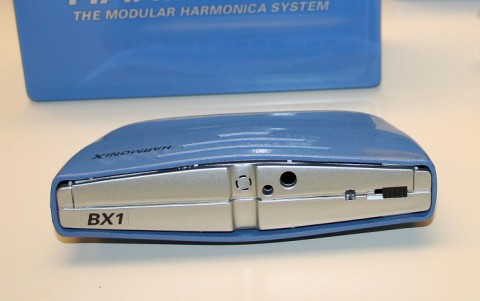 The entire unit is plastic, except of course for the reeds. The
reeds are brass, and show signs of tuning (file marks on the
reeds), but they don't play very well and I found the sound thin
and the reeds not very responsive, similar to the Huangs
I tested. I even tried playing the cartridges without the case
and didn't notice much change in play (although I could hear the
reeds more clearly - but not a recommended style of play). A careful look at the reeds showed some marks that
made me think some reeds had been bent. The C and G sounded in
tune (to my tin ear) but not the Bbm (I admit to less
familiarity with minor scales than major, but some notes just
sound off and squeaky).
The entire unit is plastic, except of course for the reeds. The
reeds are brass, and show signs of tuning (file marks on the
reeds), but they don't play very well and I found the sound thin
and the reeds not very responsive, similar to the Huangs
I tested. I even tried playing the cartridges without the case
and didn't notice much change in play (although I could hear the
reeds more clearly - but not a recommended style of play). A careful look at the reeds showed some marks that
made me think some reeds had been bent. The C and G sounded in
tune (to my tin ear) but not the Bbm (I admit to less
familiarity with minor scales than major, but some notes just
sound off and squeaky).
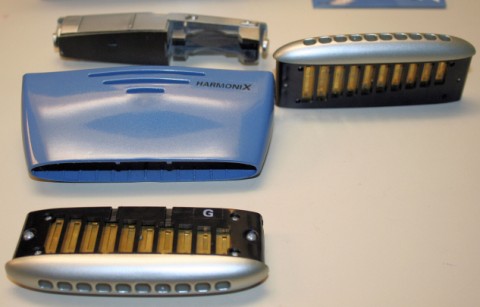 The reed cartridge design puts the player's lips further from the
actual reeds than any other harp I've seen, which makes it more
difficult to control the reeds with effects like bending. It
seems to require more breath to get a good tone than with other
harps. This may be responsible for a large part of the Harmonix's mediocre
sound. I didn't find the convex mouthpiece any problem to play,
but the design makes the middle holes even further from the
reeds than those on the edges. I found this affects your ability
to bend or overblow the further reeds, making it require more
breath to do either.
The reed cartridge design puts the player's lips further from the
actual reeds than any other harp I've seen, which makes it more
difficult to control the reeds with effects like bending. It
seems to require more breath to get a good tone than with other
harps. This may be responsible for a large part of the Harmonix's mediocre
sound. I didn't find the convex mouthpiece any problem to play,
but the design makes the middle holes even further from the
reeds than those on the edges. I found this affects your ability
to bend or overblow the further reeds, making it require more
breath to do either.
The idea of quick-change reeds is
intriguing, but the unit is too big
for comfort overall. Removing the reed cartridge is simple - tug and out
it comes. There are two tabs to guide it back in so you won't
accidentally put it in upside down. So far, so good. But the mic module is a little trickier. There are two
release buttons, one on each side you have to push in, but unless your hands are
much, much bigger than mine, you can't easily push both at once.
 Even if you can reach them, there's nothing to grab onto to remove the
cartridge. I found I had to remove the reed cartridge, press one
button, use a pen to push the module out a bit from the inside,
then do the other. That's clumsy, but you need to master it if
you use the battery-powered wireless mic module.
Even if you can reach them, there's nothing to grab onto to remove the
cartridge. I found I had to remove the reed cartridge, press one
button, use a pen to push the module out a bit from the inside,
then do the other. That's clumsy, but you need to master it if
you use the battery-powered wireless mic module.
There are no internal supports for the case, but with the mic module in place the rear is well-protected from being crushed. If you look at the case you can see the rear of the case is taller than the front. I don't know how well it will stand up, but the material seems to show wear less than the glossy cases of the Turbo Harp.
On the positive side, the main module comes with a mini-CD that has playing and maintenance tips, as well as some play-along clips (in G). Nice touch. More manufacturers should consider musical guides, not merely printed ones. Play-along clips are very cool.
The unit comes well packaged - a really nice, padded protective plastic box, packed with styrofoam ends in a cardboard box. Each reed plate comes packed in protective styrofoam in a cardboard box. But this is neither ergonomic or environmentally sound. There are no protective carriers for the reed cartridges aside from the styrofoam, and if you come up with something else to use when carrying this system to and from gigs, you likely end up tossing the styrofoam into the landfill where it ill wait for next Ice Age before it disintegrates.
 The reed cartridges won't fit in the standard harp case or belt,
either. But because they're open, I'd be concerned about getting
fluff, dirt, hair, food, etc. in the reeds without suitable
protection from the elements.
The reed cartridges won't fit in the standard harp case or belt,
either. But because they're open, I'd be concerned about getting
fluff, dirt, hair, food, etc. in the reeds without suitable
protection from the elements.
I really wanted to like this innovative design, but neither the sound nor the shape pleased me, so I was disappointed. Perhaps with better reed plates - something much more responsive like the Bushman or Suzuki reeds - it would play better. Perhaps it sounds a lot better through an amp using the integral mic, but I can't afford to test it simply to satisfy my curiosity. But even so, the shape remains problematic for me. I think it would be a lot more popular if the mouthpiece was less curved, and if the cartridges could take a different reed plate - like a Special 20 or Lee Oskar plate, instead.
MP3 samples at 160 kb/s: Harmonix C. Sound samples courtesy of my longtime musician friend and music teacher, engineer and performer extraordinaire, Rick Garner.
Would I purchase another Harmonix? no.
Would I recommend them to others? no.
Rating (0-5): **
TurboHarp
 Nov 13:
I just got a TurboHarp Turbo 20 (G), their mid-price harmonica,
and am waiting for a more expensive TurboHarp BX (low Eb).
The 20 has a funky-looking plastic shell (I chose basic biker's
black - "licorice" - instead of a more colourful lid like the
translucent tangerine...). However, it feels good in the hand,
although front-to-back it's definitely bigger than a standard
harp.
Sounds - to be assessed. I have read it uses Hohner's Special 20
reed plates - my experience with the one Special 20 I bought was
not positive, so this should be an interesting comparison.
Nov 13:
I just got a TurboHarp Turbo 20 (G), their mid-price harmonica,
and am waiting for a more expensive TurboHarp BX (low Eb).
The 20 has a funky-looking plastic shell (I chose basic biker's
black - "licorice" - instead of a more colourful lid like the
translucent tangerine...). However, it feels good in the hand,
although front-to-back it's definitely bigger than a standard
harp.
Sounds - to be assessed. I have read it uses Hohner's Special 20
reed plates - my experience with the one Special 20 I bought was
not positive, so this should be an interesting comparison.
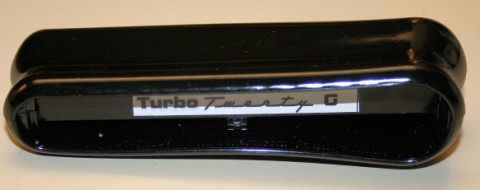 Nov.
14: If this is actually a Special 20 core (and it seems to
be - the comb has the same horizontal plastic dividers as the
S20 and some Huangs), then this harp helps restore some of my
lost faith in Hohner's Special 20. The Turbo 20 plays very well
- it seems quite loud, louder than the stock S20, with easily
bendable reeds. This increased volume must surely be the result of the ergonomic
case lids. This case easily pops apart into two pieces and can
be used on any S20 reed/comb unit. It's
easy to hold and feels comfortable in the hand - which makes me
wonder why more manufacturers don't try similar designs
(Suzuki's Firebreath comes to mind as the only other harp I've
found that comes close to how nicely the T20 fits).
Nov.
14: If this is actually a Special 20 core (and it seems to
be - the comb has the same horizontal plastic dividers as the
S20 and some Huangs), then this harp helps restore some of my
lost faith in Hohner's Special 20. The Turbo 20 plays very well
- it seems quite loud, louder than the stock S20, with easily
bendable reeds. This increased volume must surely be the result of the ergonomic
case lids. This case easily pops apart into two pieces and can
be used on any S20 reed/comb unit. It's
easy to hold and feels comfortable in the hand - which makes me
wonder why more manufacturers don't try similar designs
(Suzuki's Firebreath comes to mind as the only other harp I've
found that comes close to how nicely the T20 fits).
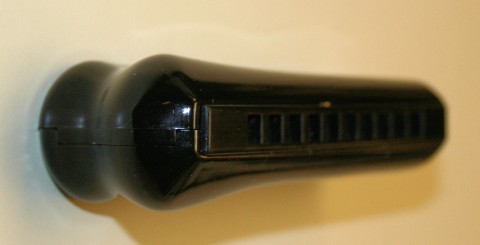 I would
really like to hear how the same design would sound with metal
rather than plastic cases. The big opening in the back, coupled
with the closed edges on the other sides helps to amplify the
sound. Metal cases might give it some real oomph and perhaps a
bit more brightness - but it may push
the higher frequencies a bit and make it brash. The sound is reasonably good.
I would
really like to hear how the same design would sound with metal
rather than plastic cases. The big opening in the back, coupled
with the closed edges on the other sides helps to amplify the
sound. Metal cases might give it some real oomph and perhaps a
bit more brightness - but it may push
the higher frequencies a bit and make it brash. The sound is reasonably good.
There are a few negatives I've found, small but evident: first you can't tell the key without looking at the back for the sticker. Most other harps have something on the front of the comb or the case. Of course you could always buy keys in different colours and learn to recognize them that way. Turbo offers a dozen or more colours from which to choose. Just be careful - the lids are easily interchangeable and you might forget what key your hot pink covers hide!
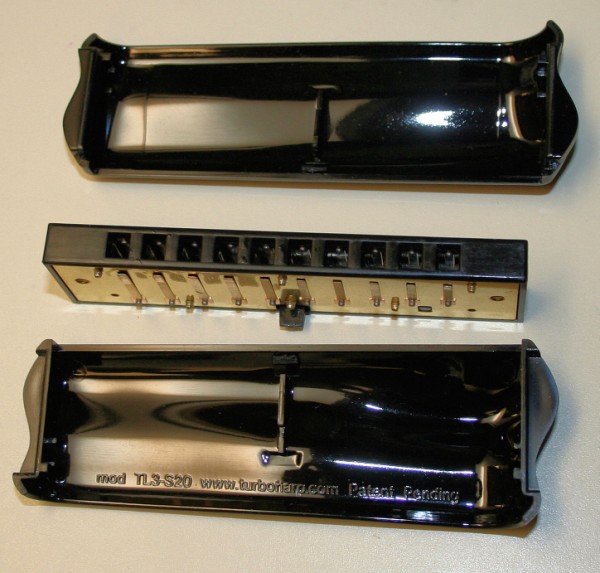 Second, maybe it's my own lack of spit, but it
seems my lips stick more to the plastic lid than to other harps
I play - but I had no problem making my lips fit the design. The shape makes the Turbo 20 difficult to store
or carry in a standard case or belt. I haven't tried it with a
harmonica holder yet, but I suspect it might need some tinkering
to hold in place tightly.
Second, maybe it's my own lack of spit, but it
seems my lips stick more to the plastic lid than to other harps
I play - but I had no problem making my lips fit the design. The shape makes the Turbo 20 difficult to store
or carry in a standard case or belt. I haven't tried it with a
harmonica holder yet, but I suspect it might need some tinkering
to hold in place tightly.
Finally, of all the harps I've received, the Turbo 20 comes with the least packaging. No box, no case, not even a plastic bag, just the harp in the mailing box. Since the plastic lid is far more susceptible to scuffing, scratching and cracking than metal, it really needs something to protect it. Mine already has some minor signs of wear (whether from my use or shipping I can't tell).
There are two small plastic tabs extending from the comb to protect the case from crushing, but I question how much protection they will provide to prevent cracking if enough pressure is applied. Although the plastic seems quite sturdy and durable, I'd be a lot more likely to recommend these if they came with something to protect them from scratching and wear.
 Dec
18: The Turbo BX arrived at my home and was there to greet
me when I arrived last night. I had asked for a low Eb, to play
along with a cut on Carlos Del Junco's latest CD. I chose a
clear shell to be able to better see the components. It's a
geeky thing, and will probably not look as clean and pretty when
I start playing it more often.
Dec
18: The Turbo BX arrived at my home and was there to greet
me when I arrived last night. I had asked for a low Eb, to play
along with a cut on Carlos Del Junco's latest CD. I chose a
clear shell to be able to better see the components. It's a
geeky thing, and will probably not look as clean and pretty when
I start playing it more often.
It came with another case to reduce any buzzing I might get with the low key. However, I haven't really noticed it doing so; to me that raw, rough sound is one of the joys of low keys. I don't mind a bit of buzz at the low end.
I was impressed with the sound - Turbo Dog's case design really stands out and the increase in volume seems very evident to my ears. This harp took a long time to arrive, but when I heard it, I immediately thought it was worth the wait. I improved my rating of Turbo Harps (the BX) from 3 to 4 stars right away. I also notice my lips don't stick to the case like they do with the T20, so I will try switching the T20's case with the spare to see it it's just that particular plastic.
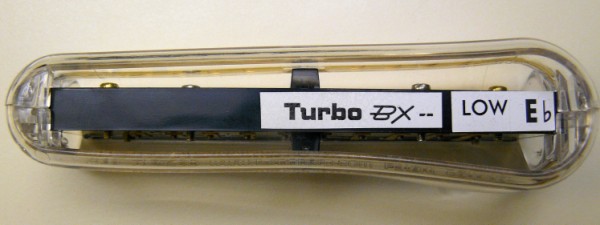 The harp is basically the same structure and design as the Turbo
20, but Turbo Dog sets up each BX individually. It was my first
experience with a customized harp and I was amazed at the
difference such attentive work can make. The reeds are responsive, bending
is easy and the sound terrific.
If this is the sound a standard Special 20 component can be
tweaked into producing , then I am doubly impressed.
The harp is basically the same structure and design as the Turbo
20, but Turbo Dog sets up each BX individually. It was my first
experience with a customized harp and I was amazed at the
difference such attentive work can make. The reeds are responsive, bending
is easy and the sound terrific.
If this is the sound a standard Special 20 component can be
tweaked into producing , then I am doubly impressed.
This time a small felt/cloth pouch is provided, but the fit is very tight. Overall, I am delighted with this harp and will likely purchase more from him.
MP3 samples at 160 kb/s: Turboharp BX Bb. Sound samples courtesy of my longtime musician friend and music teacher, engineer and performer extraordinaire, Rick Garner.
Would I purchase another TurboHarp? Possibly Turbo 20, definitely Turbo BX.
Would I recommend them to others? Yes.
Rating (0-5): ***/****
Huang
I ordered three Huang harps (Star Performer, Silvertone and Bac Pac). These are made in China, but unlike the most others made in China, this is a Chinese company making them, not an American or European company that just re-brands them and rides on their name. Despite bad experiences with some Chinese-made products I ordered some from an eBay seller.
This
web site's description just made me want to try them: "Huang
mouth organ prolongation began more than than 2 decades agone by ii ex-Hohner
mouth harp makers, Frank and Cham-ber Huang (also a amateur mouth organ
player). Incorporating their on the job and playing see, the Huang
brothers highly-developed a mathematical product run along that is like
to whatsoever of the domain famed brands. Made in a state-of-the-art
manufacturing plant in China, they are bring down in be than competitory
models, out of a give in lineament. As you in all probability live,
frequent of the "traditional? companies are manufacturing in China, in
addition producing first-class products. The Huang products take in a
wide run of diatonic harmonicas, chromatic, deep and tremolo models.
Solo and Octave tuned models are uncommitted. Many pro and recreational
players count the Huang harmonicas mixed mingled with their favourite
harps. Considering their competitory pricing, multi-key purchases are at
present affordable. Huang is invariably up their products, and
multiplied of their received products feature at present been improved
by means of 25% stronger john reed plates and best air-tightness. We
pack the intact Huang0 mathematical product run along. In buy in and
commodious to ship. Try a Huang1 mouth harp today !! You testament be a
truster !!"
 My testament will be a truster, for sure!
My testament will be a truster, for sure!
First impressions: not the highest build quality I've seen. Metal cases seem a bit thin but all three harps have a metal support top and bottom. Each model has its own case design and shape, too. The plastic carrying boxes are very inexpensive and thin, similar to the Merano cases, but that's minor. All three models can be found in online stores at $10-$15 each.
The wood-comb Bac Pac (A) doesn't seem very airtight, and takes more breath to get a sound than the other two, especially bending (higher notes in particular). The design is the traditional 'box car' shape. Sharp edges on the wood comb of the Bac Pac catch the lips noticeably. This model simply didn't move me to try it more than a few times.
 The Star Performer
(A) has a vintage 'banana' shape (a la Golden Melody) that fits the hand nicely, and weighs
12g more than the other two because of its slightly larger comb and reed
plates. Aside from its shape, I can't find any difference between it and
the Silvertone model. Huang says "The 25% heavier reed plate
construction allows reeds to swing at greater distances producing a
stronger and more powerful sound. It's the choice of demanding ROCK
stars in concert."
The Star Performer
(A) has a vintage 'banana' shape (a la Golden Melody) that fits the hand nicely, and weighs
12g more than the other two because of its slightly larger comb and reed
plates. Aside from its shape, I can't find any difference between it and
the Silvertone model. Huang says "The 25% heavier reed plate
construction allows reeds to swing at greater distances producing a
stronger and more powerful sound. It's the choice of demanding ROCK
stars in concert."
Without a micrometer to measure it, simply looking through a 10X jeweller's loupe the reed plate seems the same thickness as the Silvertone's plate, but somewhat thicker than the Bac Pac's. The Star Performer's plate is larger due to its shape, but not noticeably thicker.
I'm not sure why a thicker reed plate would allow the reeds to travel further. It may provide more resonance for the resulting sound, but I would think the actual reed itself governed the distance - the length, material and thickness affecting the flexibility. I suppose it could be a question of where the sound is actually created - is it only effective within the thickness of the reed plate? Or is it made when the reed swings free of the plate? Again, it's one of those areas still being researched.
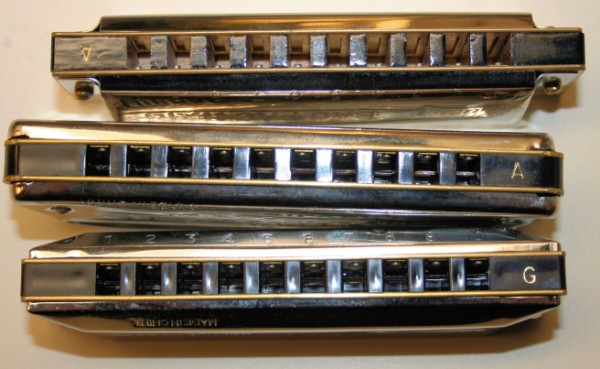 If
you look carefully at the photo of the fronts, you can see both the
Silvertone and the Star Performer have a plastic divider that separates
reed chambers, horizontally dividing each chamber. The only other diatonic harp
I've seen with this feature is Hohner's Special 20.
I've seen it in tremolo and other types, but seldom diatonics. I can't tell
without taking the harp apart how far the divider extends in the
chamber. Does the divider make a difference to the sound? None I can
hear or feel when playing, but it's another one of those things I have
not seen any literature on nor research into.
If
you look carefully at the photo of the fronts, you can see both the
Silvertone and the Star Performer have a plastic divider that separates
reed chambers, horizontally dividing each chamber. The only other diatonic harp
I've seen with this feature is Hohner's Special 20.
I've seen it in tremolo and other types, but seldom diatonics. I can't tell
without taking the harp apart how far the divider extends in the
chamber. Does the divider make a difference to the sound? None I can
hear or feel when playing, but it's another one of those things I have
not seen any literature on nor research into.
'Made in China' is stamped on the underside of the cases, and can be felt by the lips as you play. Not really a serious problem but I didn't like the rough feel and think it should have been stamped elsewhere on the case.
The banana-shaped Star Performer seems the best of the lot - the sound on all three is similar but the Star is easier to bend and more airtight. It's an adequate harp for the price, and could probably be improved by a competent harp technician. However, is it worth the extra expense when you can buy better harps off the shelf?
The Silvertone (G) is supposed to have a "special reed setting for easier bending and brilliant tone projection, but it doesn't sound to me any different from the Hohner harps, and it's harder to bend than the Star Performer (seems less airtight than the SP).
I wasn't terribly impressed by any of these harps, although the Silvertone and Star Performer are certainly better than both the Johnson and Merano harps. The Star Performer might suit a beginner who wants to learn without making a big investment. There may be some improvement in all of them, if a technician twiddles with the reeds.
Would I purchase another Huang? No.
Would I recommend them to others? Possibly the
Star Performer as an alternative to other inexpensive models.
Rating (0-5): ** 1/2
Johnson Blues Kings

My first purchase in this quest, many months ago, was a set of these Johnson Blues King harmonicas picked up on eBay. Plastic comb, made in China, thin covers, inconsistent sound, low build quality, but hey, it was under $50 for the set AND case. Some of the set sounded great (to my tin ears), but others sounded thin, reedy and many reeds didn't bend much (some buzzing there, too, especially in the upper registers).
 Overall,
I thought it was a good deal for a neophyte, and I wasn't displeased with the
sound at first. But a bit of playing showed they weren't all in
very good tune. The higher keys especially seem problematic. I
suspect an expert in harmonica tuning or repair might be able to
coax better sound and responsiveness from this line, but it
seems like a lot of work when you can buy so many better harps
that are ready to play.
Overall,
I thought it was a good deal for a neophyte, and I wasn't displeased with the
sound at first. But a bit of playing showed they weren't all in
very good tune. The higher keys especially seem problematic. I
suspect an expert in harmonica tuning or repair might be able to
coax better sound and responsiveness from this line, but it
seems like a lot of work when you can buy so many better harps
that are ready to play.
 It's a bit difficult to see, but the rear of the case is
supported by a small plastic tab extruded from the comb to help
hold it up on both sides of the case. That's good, because the cases are thin and
would bend easily under pressure.
It's a bit difficult to see, but the rear of the case is
supported by a small plastic tab extruded from the comb to help
hold it up on both sides of the case. That's good, because the cases are thin and
would bend easily under pressure.
The reed holes seem a bit smaller than the others I've reviewed, which may restrict air flow and reduce volume a bit, but it also means there is a slightly greater spacing between holes. For beginners trying to learn how to blow single notes, that's actually a positive thing because you tend to avoid hitting extra notes.
A few months after I got my set, I started to want better sound, better bending, better feel. Something good, something that sounded punchy, and something that was more consistent in quality. But the Johnsons were a good buy because they got me playing again and if I ruin one, I haven't lost a great deal. It was something to start practicing with, and a full set of all major keys and I can use the case later for better harps.
Here's a fun description of the Johnsons I came across on another site: "The Blue King mouth organ has suit celebrated since its pro go and low-toned damage. It has memorial tablet reeds that are recessed into its gamy pliant personify. This prevents beam leaks and allows in favor of liberal take note bend. The Blues King comes by the side of an single pliant caseful and clerical profession."
Who wouldn't want a harp set that came with a pliant and clerical profession? I've been told that a competent technician can make these sound and play much better, but again I question whether it's worth spending the extra when you can buy so many better harps off the shelf (albeit at much greater cost).
The Johnson set competes with several similar low-cost harps, such as Hohner's Piedmont and Fuego Azul series, the Merano line and similar harps, all of which seem to be made in China. The main difference between these and the Piedmont series is that these have metal cases, Piedmont is plastic (and only seems to come in a set of 7 harps, not 12). My advice: stay away!
Would I purchase another Johnson? No.
Would I recommend them to others? No. But the
case is good for other harps if you can get one by itself!
Rating (0-5): **
Merano
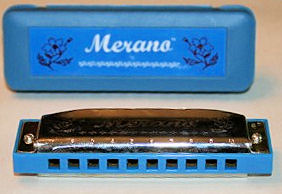
The Meranos I bought from an eBay seller - well, to be charitable - are mediocre. A Merano looks identical to the Johnsons right down to the typeface and size of the key stamped on the cover and the crews and nuts used to hold the case together. Except, of course for the name stamped in the cover, and the colour of the plastic comb. However, compared one-on-one, the Johnsons actually play and sound a little better despite the similarities (different metals? reed thicknesses? quality control?). But it's a $6 (or less!) harmonica, made in China, and you get what you pay for (I should have tried just one!).
None of the three I got - A, Eb and Bb - performed adequately, even by my amateurish standards. They all had stiff reeds, were difficult to bend and didn't sound like they were properly tuned.
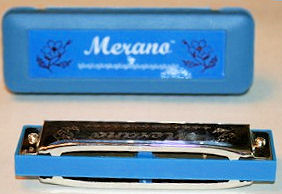 In future, I won't waste my money trying out inexpensive harps. Caveat
emptor! eBay descriptions may be more artistic than factual.
In future, I won't waste my money trying out inexpensive harps. Caveat
emptor! eBay descriptions may be more artistic than factual.
I'm not even sure I'd recommend these for a novice just learning, because I found them far less responsive and harder to bend than any better harp, even harder than the Johnsons. And the sound - well, it's simply not up to the sound produced by a more expensive product.
I think I'll use these harps as my test harps when I start trying to do my own maintenance and improvements. I certainly won't play them otherwise.
Would I purchase another Merano? No!
Would I recommend them to others? No!
Rating (0-5): *
Others
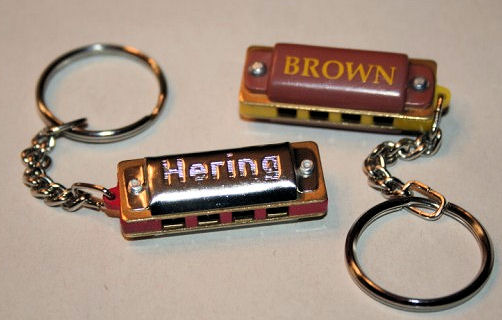 I also got two
keychain minis but they're just decoration - not really playable
unless you're calling a dog. Or a cat. My youngest cat, Abby,
bit me in the hand when I tried playing one near her.
Now I just wear them...
I also got two
keychain minis but they're just decoration - not really playable
unless you're calling a dog. Or a cat. My youngest cat, Abby,
bit me in the hand when I tried playing one near her.
Now I just wear them...
There are several larger four-hole minis (Seydel has one) that are actually playable and have full-sized reeds. There is also the small-sized Puck (see Hohner, above) and the Piccolo (the latter is also called a 'vest pocket' harmonica). I may get these sometime in the future, but they're more for the novelty than for play, at least in my use.
Seydel recently announced something different: a 'Big Six' harmonica, a mini-harp with six holes, but using the 1847 stainless steel reeds. I ordered one to test (see above). It's in C only, with 'folk' and 'blues' tunings. I ordered the blues version. It comes with a lanyard too, in case you're tempted to walk around with a harp hanging from your neck (better I suppose than wearing a name tag).
Harps I have yet to try but are in my 'wish list' or have been ordered include the Seydel 1847 and Favourite, and Hohner 365/28, a Hohner Steve Baker Special and several others including some unfamiliar tunings (many made by Seydel).
I will also try different Hering models because I don't feel the Vintage 1923 models I tested were the best representation of the brand, given the positive comments others have made of them. My biggest challenge is trying to find a source for Hering harps!
Both Hering and Hohner make 12-hole harps I am interested in comparing with the Seydel 12-hole (Hohner makes a 14-hole I want to try, too). Plus there are al those alternate layouts and tunings to sample... if my budget allows me to go much further, I will.
Amplifier and microphone reviews have been moved to a separate page.
Conclusions
You get what you pay for. Cheaper harps simply don't sound as good, they're harder to play and make bending a chore, at least for amateurs and beginners. They're not as well made and usually have inferior components and metals and are sometimes in poor tune. As a general rule of thumb, good harps start around $20-$25, better harps start around $35-40 and the top of the line diatonics sell around $60-$100.
What you hear playing is not necessarily what others hear listening. The physics of the harmonica, as well as your own physiology, your inclinations and expectations make the sound different for the player and the audience. Find the sound that pleases you. A lot of what you hear will be changed when you use a microphone and amplifier. Plus if you have any mechanical aptitude, you can tweak a harp and change its sound.
 For me - and this based solely on my limited playing experience and
skills - the best brands I tested are Seydel, Suzuki, Bushman, and Turbo
BX, followed by Lee
Oskar and Hohner in that order. But these are also divided along sound
lines: the first three are generally all brighter than the latter two and I prefer
the brighter sound. These are all good companies and they all offer
outstanding harmonicas so it's not as much about product as it is
personal taste (Hohner has some less expensive Chinese-made
products I don't recommend).
For me - and this based solely on my limited playing experience and
skills - the best brands I tested are Seydel, Suzuki, Bushman, and Turbo
BX, followed by Lee
Oskar and Hohner in that order. But these are also divided along sound
lines: the first three are generally all brighter than the latter two and I prefer
the brighter sound. These are all good companies and they all offer
outstanding harmonicas so it's not as much about product as it is
personal taste (Hohner has some less expensive Chinese-made
products I don't recommend).
My top choices all struck me as having more responsive reeds, and let me play better without as much effort. And it's really all about the reeds. But I also liked the diversity in tuning and design both Seydel and Suzuki offer. I am lukewarm about the TurboHarp 20, and rank it with Hohner, but am delighted by the BX model and would recommend it up there with the top three.
I wouldn't recommend Hering, Merano, Huang, Harmonix or Johnson based on my experiences with them. Some Hering and Huang models may suit beginners or people on a tight budget, however.
As for specific harps, I recommend the mid-range models rather than the top of the line: Suzuki Bluesmaster, Seydel Blues Session and Bushman Delta Frost. These are generally the same as the upper end models, but with plastic combs rather than metal or wood. The upper-end models may be better for pros but it's hard to justify the additional cost for my own use/abilities.
I've compiled a chart of these harps with individual data and ratings, not just group ratings.
What to do with all these extra harps? The harps I don't particularly
like will be cleaned and donated to someone who wants to learn to play,
probably a young student. I may also take some to Mexico with me and
donate them to kids down there. Or maybe I'll sell them as a lot on eBay
- 25-50 gently used harmonicas, good price... The rest I will keep and play - and
practice, practice, practice.
Amplifier and microphone reviews have been moved to a separate page.
Update: This exercise left me with a rather large collection of harmonicas, many of which I realized I would never play again. I separated out those I thought I would return to, and sold the rest in one lot on eBay, in June 08. I kept most of the Seydels, Suzukis, Hohners, Bushman, Lee Oskars and TurboHarp harmonicas. The Johnsons, Meranos, Hering, Huangs, Harmonix and some of the differently-tuned harmonicas went to another player who purchased them for a very good bulk price. I may still thin the herd a bit because I realize I have enough duplicate keys to keep a couple of each, sell the rest and still have a good collection. The money will be used to help fund my current instrument review page: ukuleles.
Sources and Links
